- Career Blog

What Is an Enclosure in a Cover Letter? Definition & Tips

Cover letters are important documents that accompany a job application. They serve as an introduction to the candidate and provide an opportunity to highlight their relevant skills and experiences. A well-written cover letter can help a candidate stand out in a crowded field of applicants.
One aspect of a cover letter that is often overlooked is the enclosure. An enclosure is a document that is included with the cover letter, such as a resume, writing sample, or other supporting materials. The purpose of the enclosure is to provide additional information that supports the candidate’s qualifications.
In this article, we will delve into the definition and purpose of an enclosure in a cover letter. We will explore the various types of documents that can be included as enclosures, and provide tips on how to effectively use them to strengthen your application. By the end of this article, you will have a clear understanding of what an enclosure is and how to use it to your advantage in your job search.
Where to Include Enclosures
When it comes to including enclosures in your cover letter, it’s important to know where to include them based on the type of cover letter you will be using. Here are the different places to include enclosures depending on the type of cover letter you are using:
A. Electronic Cover Letters
Email: If you are submitting your cover letter via email, you can include the enclosure either in the body of the email or as an attachment. If you choose to include it as an attachment, make sure to mention it in the body of your email as well.
Online Submission Forms: Some companies may require you to submit your cover letter through an online submission form. In this case, there may be a designated section where you can upload your enclosure.

B. Physical Cover Letters
Mailing: If you are mailing your cover letter, you can include the enclosure by stapling it to the cover letter or placing it in the same envelope. Make sure to mention in your cover letter that you have enclosed additional materials.
Hand Delivery: If you are hand delivering your cover letter, you can either staple the enclosure to the cover letter or include it in a separate folder or envelope.
Remember, including enclosures can be a great way to provide additional information about yourself to potential employers, but make sure to only include relevant and necessary materials.
Types of Enclosures
When submitting a cover letter, you may be required to include various types of enclosures. These can include a resume, CV, references, writing samples, certifications, relevant projects, and other supporting documents. In this section, we will go through each of these types in detail to help you understand what they are and how to include them in your cover letter.
A resume is a document that summarizes your work experience, education, and relevant skills. It is typically a one-page document that showcases your professional accomplishments and provides a quick overview of your qualifications. When including your resume as an enclosure in your cover letter, make sure it is up-to-date and relevant to the job you are applying for.
A CV, or curriculum vitae, is a more comprehensive document than a resume. It includes not only your work experience and education but also publications, presentations, and other academic achievements. A CV is commonly used in academic or research settings and can be longer than two pages. If the job you are applying for requires a CV, be sure to include it as an enclosure in your cover letter.
C. References
When applying for a job, it’s important to have references who can attest to your professional capabilities. Including a list of references as an enclosure in your cover letter can demonstrate your preparedness and readiness to work with the company. Be sure to ask permission from your references before including them in your cover letter.
D. Writing Samples
If the job you are applying for involves writing or requires a specific writing style, including writing samples as enclosures in your cover letter can help demonstrate your skills. Choose samples that are relevant to the job and showcase your unique writing style.

E. Certifications
If you have certifications relevant to the job you are applying for, including them as enclosures in your cover letter can provide additional credibility to your application. These can be industry-specific certifications or general ones like CPR or First Aid.
F. Relevant Projects
If you have completed relevant projects in your field or have personal projects that demonstrate your skills, including them as enclosures in your cover letter can set you apart from other applicants. Be sure to explain the relevance of each project to the job you are applying for.
G. Other Supporting Documents
If there are other supporting documents that you believe can help showcase your qualifications for the job, including them as enclosures in your cover letter can be beneficial. These can include publications, awards, or other relevant materials.
When submitting a cover letter, including enclosures can help demonstrate your qualifications and professionalism. Be sure to choose the appropriate type of enclosure for the job you are applying for and ensure they are relevant and up-to-date.
Proper Formatting and Labeling for Enclosures
Enclosures are an important component of a cover letter and serve as a means to provide additional information to the recipient. To ensure that the enclosures are easily identified and understood, it is important to use proper formatting and labeling.
A. Labeling Guidelines
When labeling enclosures, it is important to use clear and concise language that accurately describes the enclosed documents. Use a descriptive title, such as “Resume” or “References,” to clearly indicate the type of document enclosed. Avoid using vague titles, such as “Documents,” which do not provide any meaningful information.
It is also important to number the enclosures to ensure that they are accounted for and that none are missing. Use a consistent numbering system, such as “Enclosure 1,” “Enclosure 2,” etc., and include the corresponding number in the cover letter or email. This will make it easier for the recipient to cross-reference the enclosed documents with the cover letter or email.
B. Location of the Label
The label for the enclosure should be placed either at the top or bottom of the document. If you choose to place the label at the top, center it and make it bold and slightly larger than the text in the body of the document. If you place the label at the bottom, align it with the left margin.
C. Aligning Multiple Enclosure Labels
If you are enclosing multiple documents, it is important to align the labels to make them easier to read and reference. Align the labels either horizontally or vertically, depending on the number of enclosures and the available space. Remember to number the enclosures in the order in which they appear in the cover letter or email.
For horizontal alignment, place the labels side-by-side and evenly spaced. For example:
Enclosure 1 Enclosure 2 Enclosure 3
For vertical alignment, stack the labels one on top of the other, aligned with the left margin. For example:
D. Placement of Enclosures in the Cover Letter
In the cover letter, mention the enclosed documents and briefly describe their contents. This will provide the recipient with an idea of what to expect and help them quickly locate the relevant information.
Place the enclosure label(s) after the closing and signature of the cover letter or email. This will ensure that the recipient sees the label(s) before they begin reviewing the enclosed documents.
Proper formatting and labeling of enclosures are essential in a cover letter. Use descriptive titles and consistent numbering, place the label at the top or bottom of the document, align multiple labels, and mention the enclosed documents in the cover letter. Following these guidelines will help ensure that the recipient can quickly and easily identify and review the enclosed documents.
Tips for Including Enclosures in a Cover Letter
When it comes to enclosing additional documents or materials with your cover letter, it’s important to follow some simple guidelines to ensure that you’re including the right information in the right way. Here are some key “do’s” and “don’ts” to keep in mind:
A. Do’s for Enclosing on Cover Letter
Keep It Relevant: Any materials you include with your cover letter should be directly related to the job you’re applying for. Whether it’s a writing sample, a project proposal, or a portfolio of your work, make sure that everything you include is relevant to the position and will help the hiring manager get a better sense of your skills and experience.
Label It Correctly: Make sure that any additional documents or materials you enclose are clearly labeled with a title or description that makes it clear what they are. This will help the hiring manager easily locate and review the materials as needed. Additionally, if you’re sending multiple documents, consider numbering them to help keep them organized.
Make It Easy to Access: Whether you’re submitting your materials electronically or physically, make sure that they’re easily accessible and available to the hiring manager. If you’re emailing your application, consider including links to your materials rather than attaching large files. If you’re sending a physical application, make sure the materials are neatly organized and easy to locate.
B. Don’ts for Enclosing on Cover Letter
Including Too Much Information: While it’s important to include any relevant materials that will help the hiring manager get a better sense of your skills and experience, you don’t want to overload them with unnecessary information. Stick to the most important and relevant materials, and avoid including anything that doesn’t directly support your application.
Forgetting to Label: It’s easy to get caught up in the process of assembling your application materials, but don’t forget to clearly label each document or material that you include. Without clear labeling, the hiring manager may not know what they’re looking at or how it relates to your application.
Including Unrelated Documents: Finally, make sure that any additional materials you include are directly related to the job you’re applying for. While your resume or cover letter might be tailored to multiple positions, any additional materials you include should be specific to the job at hand. Resist the temptation to include unrelated documents or materials that won’t help build your case for why you’re the best candidate for the position.
By following these simple guidelines for including enclosures with your cover letter, you’ll be able to present a clear and compelling case for your candidacy while making it easy for the hiring manager to review your application.
Common Mistakes to Avoid when Enclosing on Cover Letter
When creating a cover letter, it is important to avoid making common mistakes that can have a negative impact on your application. Here are some common mistakes to avoid when enclosing documents with your cover letter.
A. Wrong Document Type
One common mistake applicants make is enclosing the wrong type of document with their cover letter. For example, enclosing a resume when the employer only requested a cover letter can make you seem careless or unprofessional. Be sure to carefully read the job posting or application instructions to determine what documents are required.
B. Typos and Grammatical Errors
Another mistake to avoid when enclosing on your cover letter is having typos and grammatical errors. These mistakes can make you appear less credible and distract from the content of your application. Take time to proofread and edit your cover letter before submitting it.
C. Improper Formatting
Improper formatting is another mistake that applicants make on their cover letters. Using difficult to read fonts, too much bolding, or not enough white space can make your cover letter difficult to read. It is best to keep your cover letter simple, clean, and easy to read.
D. Not Including Contact Information
A final common mistake to avoid when enclosing documents with your cover letter is not including your contact information. This information should include your name, email address, phone number, and mailing address. You can include this information at the top of your cover letter or in the signature block. This allows the employer to easily contact you if they have any questions or want to schedule an interview.
By avoiding these common mistakes when enclosing your documents on your cover letter, you can increase your chances of making a positive impression with potential employers. Take the time to carefully review and edit your application materials to ensure that you are presenting yourself in the best possible light.
The Importance of Enclosure in a Cover Letter
A well-crafted cover letter is an essential part of any job application process. It serves as a marketing tool to showcase your qualifications, skills, and experience that make you the perfect candidate for the position. However, one aspect that is often overlooked by job seekers is the inclusion of enclosures in their cover letter. An enclosure refers to any additional documents that support your application, such as your resume or portfolio.
But why is the enclosure section so important, and what does it say about you as a candidate?
A. Shows Your Professionalism
First and foremost, the inclusion of an enclosure section in your cover letter displays professionalism. It shows the hiring manager that you are detail-oriented, organized, and have taken the time to provide them with all the necessary documents upfront. Remember, hiring managers receive hundreds of applications, and anything you can do to set yourself apart and make their lives easier will be greatly appreciated.
B. Provides Additional Information
Moreover, the enclosure section can provide employers with additional information that may not be readily apparent in your resume or cover letter. For example, if you are applying for a graphic design position, you could include samples of your work in the enclosure section to showcase your design skills. Similarly, if you are a recent graduate, you could include transcripts to demonstrate your academic abilities.
C. Demonstrates Attention to Detail
Lastly, the enclosure section is a great way to demonstrate attention to detail. It shows that you have carefully read and followed the application instructions, including any requests for additional documents. Employers want to hire candidates who pay attention to the details and take pride in their work.
Including an enclosure in your cover letter is crucial. It not only shows your professionalism, but it can also provide employers with additional information and demonstrate your attention to detail. So, make sure to take the time to gather all the necessary documents and present them in a clear, organized manner. Your effort will not go unnoticed by potential employers, and it may just be the thing that sets you apart from other candidates.
Example of Cover Letter Enclosure
A. cover letter example.
Dear Hiring Manager,
I am writing to apply for the [Position] role at [Company]. Enclosed, please find my resume, along with other supporting documents that I have included for your review.
As a skilled [Industry] professional with [Number] years of experience, I am confident in my ability to contribute positively to [Company] and hit the ground running in this position. My experience in [Skill 1], [Skill 2], and [Skill 3] have prepared me well for this role and I am excited about the opportunity to put my skills to use.
I am particularly drawn to [Company’s] focus on [Specific Aspect of Company], and the impact that your work has on [Customer, Industry, etc.]. I am motivated by a desire to be a part of this work and contribute to its continued success.
Thank you for considering my application. Please feel free to contact me if you need any additional information or to discuss my qualifications further.
[Your Name]
B. Enclosure Example
Enclosures:
- Cover Letter
- Professional References
I am writing to express my interest in the [Position] role at [Company]. Enclosed, please find my resume, cover letter, and professional references that I have included for your review.
As a qualified [Industry] professional with [Number] years of experience, I am confident in my ability to make a valuable contribution to [Company]. I am excited about this opportunity to use my skills in [Skill 1], [Skill 2], and [Skill 3] to support your team.
Thank you for taking the time to review my application. Please feel free to contact me if you need any additional information or to discuss my qualifications further.
Related Articles
- Line Leader: Job Description, Salary, and Skills for 2023
- Full Stack Developer Resume: Example & Writing Tips for 2023
- Writing a Chronological Resume: Tips and Samples for 2023
- Reference Letter Template for Employment in 2023
- How to Create the Best Resume in 2023: Complete Guide
Rate this article
0 / 5. Reviews: 0

More from ResumeHead

What Is An Enclosure In A Cover Letter
In This Guide:

An enclosure in a cover letter refers to additional documents that are being sent along with the letter, such as a resume or a portfolio. The enclosure is typically mentioned at the end of the letter, after the closing, and is indicated by the word "Enclosure" or "Enclosures" followed by the number of documents included.
For example, "Enclosure: 1 resume" or "Enclosures: 2 writing samples, 1 reference list."
- Cover Letter Guides
Expert Guide on How to Get a Job at a Nonprofit
Compétences linguistiques sur un cv : comment expliquer la connaissance et la maîtrise d’une langue, how to write a resume after a career break, how to write an effective resume profile (with examples), part-time job on resume: how to include it, ahead of the trend: how quiet hiring could affect your career in 2024.
- Create Resume
- Terms of Service
- Privacy Policy
- Cookie Preferences
- Resume Examples
- Resume Templates
- Resume Builder
- Resume Summary Generator
- Resume Formats
- Resume Checker
- AI Resume Review
- Resume Skills
- How to Write a Resume
- Modern Resume Templates
- Simple Resume Templates
- Cover Letter Builder
- Cover Letter Examples
- Cover Letter Templates
- Cover Letter Formats
- How to Write a Cover Letter
- Resume Guides
- Job Interview Guides
- Job Interview Questions
- Career Resources
- Meet our customers
- Career resources
- [email protected]
- English (UK)
- French (FR)
- German (DE)
- Spanish (ES)
- Swedish (SE)
Made with love by people who care.
© 2024 . All rights reserved.
Practical Cover Letter Enclosure Tips and Examples

Table of Contents
Have you ever wondered if there's a secret ingredient that could make your job application stand out from the rest? Something that signals your professionalism and attention to detail to potential employers? A well-crafted cover letter enclosure is what you need. In this comprehensive guide, we will delve into what exactly an enclosure in a cover letter entails, why it could be a critical addition to your application, and how to effectively use it to boost your chances of landing an interview.
Whether you aim to showcase a portfolio of work, certifications, or other essential documents, understanding the use of a cover letter enclosure could set your application apart in a crowded job market. Let’s explore how this simple yet powerful tool can enhance your application and help you make a memorable impression on your potential employer.
What Is an Enclosure in a Cover Letter?
An enclosure notation in a cover letter is a formal way of informing the recipient that additional documents accompany the letter. This notation is typically placed at the end of the cover letter, serving as a signal to the hiring manager or recruiter to expect further materials. These could include a resume, relevant certificates, or a sample letter with enclosed documents that enhance your application.
This notation is crucial as it ensures all submitted documents are noted and reviewed. By clearly indicating enclosures, you help organize your application package and make it easier for the employer to verify your qualifications and experiences. Understanding what an enclosure in a cover letter is and how to use it effectively can significantly impact how your application is perceived, underscoring your thoroughness and attention to detail.
Reasons Why You Might Want to Use a Cover Letter Enclosure
Including a cover letter enclosure can enhance your job application in several significant ways:
- Supporting Documents : This section allows you to include important additional documents such as a detailed portfolio, letter of recommendation, or precise project descriptions that showcase your skills and experiences relevant to the job.
- Professionalism : Your professionalism and attention to detail are evident. Including enclosures shows that you have taken the extra step to provide comprehensive information.
- Preparedness : This indicates that you are well-prepared and serious about the application. It can make a strong impression on potential employers by highlighting your dedication to the role.
- Verification of Qualifications : This helps potential employers verify your qualifications and experiences directly, enabling them to assess your suitability for the position more effectively.
- Enhanced Presentation : Improves the overall presentation of your application. Well-organized documents neatly referenced in your cover letter make it easier for hiring managers to review your credentials.
Utilizing a cover letter enclosure effectively ensures that your application is complete and stands out in a competitive job market by reinforcing your qualifications and readiness for the position.
How to Write a Cover Letter Enclosure
To write an effective cover letter enclosure, specify the documents you include at the end of your cover letter. Simply add the word "Enclosures:" followed by a list of the papers you're attaching, such as your resume, portfolio, or letters of recommendation. It's essential to itemize each document to maintain clarity and organization.
Additionally, you can reference these documents in your cover letter to highlight their relevance and explain why they are crucial for understanding your qualifications and suitability for the position. This method ensures that the hiring manager is aware of the additional materials and emphasizes your thoroughness and attention to detail in the application process.
Which documents should I put in my enclosure?
The documents you choose to enclose should directly support your job application. Common choices include resumes, letters of recommendation, work portfolios, and certificates relevant to the job description. Prioritize priority documents that highlight your career accomplishments and align with the job posting.
What should be avoided in the cover letter enclosure?
When assembling your enclosure, avoid including unnecessary or overly personal documents. Keep the content professional and relevant to the job application process. It's also essential to avoid grammatical errors and ensure all information is up-to-date and pertinent to the job titles you're applying for.
How to Add an Enclosure to Your Cover Letter
Adding an enclosure to your cover letter is crucial in ensuring that the hiring manager acknowledges all your supplementary documents. To do this effectively, you should conclude your cover letter by noting that additional documents are enclosed. The standard way to indicate this is by using the term "Enclosures:" followed by a list of the items you include, such as resumes, portfolios, or letters of recommendation.
This enclosure notation should be strategically placed at the bottom of your cover letter, ideally aligned with your signature and typed name. This placement keeps your application materials organized and maintains a neat and professional appearance. By clearly listing your enclosures, you ensure the recipient is aware of all the documents provided, facilitating a thorough review of your application.
Excellent Cover Letter Enclosure Examples
Using solid examples in your cover letter enclosure can significantly enhance your application. Here are some practical ways to align your enclosures with the job requirements:
- Graphic Design Role : Include project samples highlighting your unique style and effectiveness. This digital portfolio could showcase various aspects of your design work.
- Marketing Position : Enclose case studies or campaign summaries that you have orchestrated and have had measurable success. These documents demonstrate your ability to strategize and execute marketing plans.
- Research Position : Attach published papers or abstracts of your research that are relevant to the position you're applying for. This shows your expertise and contributions to your field.
- Teaching Job : Include a compilation of teaching evaluations and sample lesson plans. This demonstrates your effectiveness in the classroom and your approach to education.
- Engineering Role : Enclose patents, technical drawings, or project specifications you have worked on. These documents provide concrete examples of your technical skills and innovative thinking.
Each of these examples tangibly illustrates your qualifications, helping to create a memorable impression on potential employers by directly relating your past work to the job requirements.
A cover letter enclosure can significantly enhance your job application, setting you apart from other candidates. You provide tangible proof of your qualifications and readiness for the role by including well-chosen documents. Remember, every element of your application is an opportunity to showcase your skills and professionalism.
Visit RampedCareers for more insights and tools to accelerate your career journey. Let's ensure your job applications are as strong as possible, landing interviews and job offers faster.
Whether you want to polish your resume, craft compelling cover letters, or develop your professional network, we are here to assist. Visit us at RampedCareers and make sure your job applications are as impactful as possible. This will help you secure interviews and job offers faster. Join us and take your career to the next level!
Things You Need While Searching for a Job
Once you are armed with the knowledge about what kind of job will make you happy, there are core things to get lined up for a job search. Let's look at a few.
What to Look for in a Job
Fun fact, most people will have about 12 different jobs in their working lifetime. This goes to show that finding a job that you love enough to hang onto takes some forethought and possibly a bit of trial and error. Just the same, you can make some plans in advance, helping you land in a position that leaves you perfectly content. Check out a few things to look for when looking for that perfect job.

Related content

Learn how to show promotion on a resume effectively. Explore the pros, cons, and best tips for showcasing multiple positions in the same company in a resume.

List minors on a resume to boost your qualifications. Tips and formatting options are included. Get your resume ready for potential employers today!

Learn how to make your resume stand out in today's competitive job market with our expert tips. Get noticed by hiring managers. Visit www.rampedcareers.com for more.
What Does Enclosure Mean on a Cover Letter – Navigating Your Job Application Documents
Table of Contents
When discussing an enclosure in a cover letter, we refer to additional documents in your application. These documents provide further information about your qualifications and experiences. It’s crucial to mention them in your cover letter to alert the hiring manager that there’s more to see than just the letter itself. Including suitable enclosures can be a game-changer in your job application, so let’s ensure you’ve got everything in place. Ready to perfect your application? Keep reading to learn how to master the use of enclosures.
Understanding the Enclosure Line in Cover Letters
At the end of your cover letter, the term ‘enclosure’ signals the hiring manager that additional documents are included for review. It’s a simple yet essential notation that ensures your additional credentials are noticed. Consider it as a courteous heads-up to the reader to check for more.
Defining ‘Enclosure’ in Job Application Context
In the context of a job application, an ‘enclosure’ refers to any supplementary document or item that accompanies your cover letter. These materials support your candidacy and provide tangible evidence of your professional background.
The Purpose of Enclosures in Your Application
Enclosures serve to bolster the claims made in your cover letter. They provide the substance behind your story, showing hiring managers the hard evidence of your skills and achievements. It’s about making your case as concrete as possible.
Supplementing Your Cover Letter
Enclosures are there to complement the narrative of your cover letter. They add depth to your professional tale, offering a fuller picture of who you are as a candidate. It’s about giving substance to the promises of your prose.
Providing Proof of Qualifications and Experience
By including enclosures, we are providing proof of our qualifications and experience. These documents validate our credentials, showing potential employers that we have the background and skills they seek. It’s evidence that we can walk the walk.
Resume or Curriculum Vitae (CV)
A resume or CV is the cornerstone of job application enclosures. It summarizes your professional history, education, and skills, providing a snapshot of your career trajectory and qualifications. Ensure it’s updated and aligned with your cover letter.
Certifications or Licenses
Certifications or licenses prove that you have specific qualifications or legal permissions necessary for the job. These documents underscore your specialized knowledge and commitment to professional development. Include copies if they’re relevant to the position.
Letters of Recommendation
Letters of recommendation are powerful endorsements from previous employers or notable professionals in your field. They offer a third-party perspective on your abilities and work ethic. Include them to add weight to your application.
Work Portfolio Samples
For many creative or technical roles, work portfolio samples are indispensable. They showcase your previous projects and highlight your talent. Include samples that are particularly relevant to the job you’re applying for to demonstrate your expertise.
How to Properly Format Enclosures in Your Cover Letter
Formatting enclosures in your cover letter is straightforward but essential. A neat and organized presentation ensures the hiring manager can easily find and review each document. Proper formatting reflects your attention to detail and professionalism.
Placing the Enclosure Notification
The enclosure notification typically appears at the end of your cover letter. It can be a single line stating “Enclosure:” followed by a list of the documents. This tells the reader to look for additional materials included with your application.
Labeling Your Documents Correctly
Each enclosed document should be clearly labeled with a descriptive title. This helps the hiring manager understand what they’re looking at and why it’s relevant. Clear labels facilitate a smoother review process and demonstrate your organizational skills.
Numbering Multiple Enclosures
If you have several enclosures, it’s helpful to number them. This keeps your documentation in order and ensures that everything gets noticed. Think of it as creating a roadmap for the hiring manager to follow through your professional landscape.
Descriptive Titles for Easy Reference
When we list our enclosures, it’s essential to use descriptive titles so the hiring manager can quickly identify each document. For example, instead of labeling a document as “Certification,” we might specify “Project Management Professional Certification.” This clarity helps the reader know what to expect before opening any file, and it can also demonstrate our organizational skills and attention to detail.
Tips for Electronically Submitting Enclosures
In the digital age, we often submit our job application enclosures electronically. Maintaining a professional approach is crucial, just as we would with physical copies. This means checking the employer’s submission guidelines, using appropriate file formats, and ensuring each document is labeled and organized. These steps help ensure our enclosures are received and reviewed without technical hitches.
File Naming Conventions
For electronic submissions, file naming is vital. We must use a consistent and clear naming convention for all our documents. A good practice is to start with our last name, followed by the document type and the date, like “Smith_Resume_2023.pdf.” This makes it easier for hiring managers to locate and reference our files among many applications.
Ensuring Accessibility and Compatibility
Ensuring our documents are accessible and compatible across different platforms is essential. We stick to widely recognized formats like PDF for text documents and JPEG for images. Before sending, we check that our enclosures can be opened on multiple devices, safeguarding against potential viewing issues that could prevent our materials from being reviewed.
The Significance of Enclosures for Your Application’s Success
Enclosures are more than just additional paperwork; they represent the substance behind our claims in our cover letter. By providing concrete evidence of our skills and experiences, enclosures can significantly strengthen our job application and increase our chances of being noticed by potential employers.
Enhancing Your Professional Presentation
Strategically chosen enclosures enhance our professional presentation by showcasing our qualifications and achievements. They provide tangible proof of our capabilities, allowing employers to see the depth and breadth of our experience beyond what’s summarized in the cover letter or resume.
Differentiating Your Application from Others
Well-selected enclosures can set our application apart from the competition. They allow us to highlight unique experiences, specialized skills, or notable accomplishments that may need to be more evident in our resume. This differentiation can be the tipping point that nudges our application to the top of the pile.
Avoiding Common Mistakes With Enclosures
It’s essential to avoid common mistakes with enclosures, such as forgetting to include a document mentioned in the cover letter. This oversight can make us appear careless or disorganized. We must ensure that every enclosure we reference is attached to our application to maintain credibility and professionalism.
Omitting Enclosures Mentioned in the Cover Letter
If we refer to an enclosure in our cover letter, we must include it in our application. Omitting promised enclosures can make employers question our attention to detail. We double-check our application packet before submission to avoid this pitfall.
Including Irrelevant or Unrequested Documents
Including irrelevant or not-requested documents can work against us by overwhelming the hiring manager with unnecessary information. We focus on enclosures pertinent to the job and align with the employer’s requests, ensuring that each document clearly supports our application.
Preparing for Follow-Up After Your Application is Submitted
We must prepare for what comes next once our application is out the door. Whether it’s an inquiry about our enclosures or a request for additional information, we should have our documents organized and at hand for quick response. This preparedness demonstrates our enthusiasm and readiness for the position.
How to Handle Missing or Additional Enclosures
If we discover that an enclosure is missing or need to submit an additional one, it’s crucial to act promptly. We should contact the employer as soon as possible with an updated document list and a polite note explaining the oversight or the update. This shows our proactive nature and commitment to transparency.
Discussing Enclosures During Job Interviews
Enclosures can come up during job interviews; we should be prepared to discuss them. Whether providing context for a project in our portfolio or elaborating on certifications, we need to be ready to speak confidently about each document and how it relates to our ability to excel in the role.
Preparing Physical Copies for In-Person Interviews
For in-person interviews, we often bring physical copies of our enclosures. This shows foresight and ensures that we’re prepared even if the interviewer doesn’t have them. Preparing our documents can facilitate the discussion and give us an edge in the interview process.

Addressing Enclosure-Related Questions Confidently
When asked about our enclosures, we maintain confidence and poise. It’s our chance to highlight these documents’ strengths and relevance to the position. We should be familiar with each and ready to explain how they showcase our qualifications.
Elevating Your Job Search With Strategic Enclosures
Strategically chosen enclosures can elevate our job application, making us stand out in a crowded field. By carefully selecting documents that align with the job requirements, we create a targeted application that speaks directly to the employer’s needs and increases our chances of success.
The Impact of Well-Chosen Enclosures on Hiring Decisions
Well-chosen enclosures have a significant impact on hiring decisions. They can be the deciding factor that tips the scales in our favor, providing tangible evidence of our skills and achievements. By selecting the correct documents, we help hiring managers see the value we can bring to their company.
Utilizing Enclosures to Tell a Compelling Career Story
Each enclosure we include is a chapter in our career story. Together, they weave a narrative highlighting our journey, the skills we’ve gained, and our proud accomplishments. By using our enclosures to tell this story compellingly, we engage the hiring manager and leave a memorable impression.
Wrapping Up: Sealing the Deal With Your Enclosures
As we reach the end of our journey in perfecting job application enclosures, it’s vital to remember their power in complementing your cover letter and resume. Carefully chosen enclosures are the final puzzle pieces that complete the picture of who you are as a professional. They provide tangible evidence of your skills, experiences, and accomplishments, making your application more persuasive.
By ensuring each document is relevant, up-to-date, and presented clearly and professionally, we increase the likelihood of making a lasting impression. Let’s ensure our enclosures are the ace in the hole that clinches the deal, showcasing us as the standout candidates we are. With a final review for precision and relevance, we’re ready to submit applications that meet the mark and soar beyond expectations.
Frode Osen is one of Norway’s leading CV and application writers, and built his career at CVGuru.no . With a portfolio of more than 750 satisfied clients from most sectors you can think of, he holds the expertise to craft documents that significantly enhance your job prospects. His goal is to help you secure interviews for your dream job by presenting your skills and experiences effectively, shaping application documents that make it easier to take the next step in your career. You can easily connect with Frode Osen on LinkedIn .
Related posts:
Leave a Comment Cancel reply
Save my name, email, and website in this browser for the next time I comment.
What does enclosure mean on a cover letter?
1. why is it important to mention an enclosure on a cover letter, 2. what should i include as an enclosure on a cover letter, 3. how should i format the enclosure notation on my cover letter, 4. should i always include an enclosure on my cover letter, 5. can i include too many enclosures on my cover letter, 6. should i mention the enclosures in the body of the cover letter too, 7. is it acceptable to include digital enclosures, such as links or online portfolios, 8. can i mention enclosures if i am submitting my application online, 9. should i mention enclosures if they have already been listed in the application form, 10. what if i forget to include an enclosure i mentioned on my cover letter, 11. can mentioning enclosures increase my chances of getting an interview, 12. how can i ensure that the employer notices the enclosures, 13. should i staple the enclosures together or leave them loose, 14. can i mention the enclosures if they are already mentioned on my resume, 15. can i mention past accomplishments as enclosures on a cover letter, what does enclosure mean on a cover letter.
In the world of job applications, cover letters play a crucial role in presenting yourself as a potential candidate. Cover letters allow you to showcase your skills, experiences, and qualifications to potential employers. While most people are familiar with the basic components of a cover letter, one element that often raises questions is the term “enclosure.” So, what does enclosure mean on a cover letter? Let’s delve into this topic and find out.
Enclosure on a cover letter refers to any additional documents or materials that you are including with your application. These could be your resume, portfolio, certificates, or any other relevant documents that you believe will provide further insight into your qualifications and suitability for the role. By indicating the inclusion of these materials, you are informing the employer that there are additional items accompanying your cover letter.
Including an enclosure notation on your cover letter is beneficial for several reasons. Firstly, it ensures that the employer knows to expect additional documents, minimizing the chances of them overlooking crucial information. Secondly, it demonstrates your attention to detail and professionalism, as you are aware of the standard practices when it comes to submitting job applications. Lastly, it allows you to highlight relevant accomplishments or showcase your work samples that may not be explicitly mentioned in the cover letter itself.
When you mention an enclosure on a cover letter, you are ensuring that the employer knows there are additional materials accompanying your application. This can help in grabbing their attention and ensuring that they review your entire application thoroughly.
The enclosure on your cover letter can include various documents such as your resume, portfolio, writing samples, reference letters, or any other relevant materials that showcase your qualifications and achievements.
Typically, the enclosure notation is added at the bottom of the cover letter, after your signature. You can simply write “Enclosure” or “Enclosures” followed by a colon and then list the documents included.
Including an enclosure on your cover letter is not mandatory, but it is often recommended if you have supporting documents that add value to your application. If you believe that additional materials will strengthen your candidacy, it’s a good idea to mention them.
While you can include multiple enclosures, it’s essential to ensure that they are all relevant and contribute to your application. Avoid overwhelming the employer with an excessive number of enclosures that may dilute the impact of your core message.
Although not necessary, it can be helpful to mention the enclosures briefly in the body of your cover letter. This allows you to draw attention to specific documents and provide context for their relevance.
Absolutely! In this digital age, including digital enclosures is widely accepted. You can provide links to your online portfolio, LinkedIn profile, or any other relevant online resources that showcase your qualifications and achievements.
Yes, even when submitting applications online, it is a good practice to mention the enclosures in your cover letter. This ensures that the employer knows there are additional materials accompanying your application, and they can access them easily.
If you have already listed the enclosures in the application form or an online submission portal, you may choose to exclude the enclosure notation from your cover letter. However, it does no harm to reiterate the inclusion briefly to ensure the employer’s awareness.
Ideally, you should ensure that you enclose all the items you mention on your cover letter. However, if you accidentally miss one, it’s better to send it separately with a polite follow-up email, acknowledging your mistake and offering to provide the missing document.
While mentioning enclosures alone may not guarantee an interview, it does create a more comprehensive and professional impression. It enhances your chances by providing the employer with additional evidence of your qualifications and achievements.
To ensure that the employer notices the enclosures, you can consider using appropriate formatting in your cover letter, such as bolding or underlining the word “Enclosure” in the enclosure notation. Additionally, you can mention the enclosures in your introductory paragraph or highlight their importance in relation to the position.
It is generally recommended to staple the enclosures together to keep them organized and presentable. However, if your documents are too thick, using a paperclip or a document binder can be a suitable alternative.
While the contents of your resume may overlap with the enclosures, it is still beneficial to mention them in your cover letter. This ensures clarity and leaves no room for ambiguity when the hiring manager assesses your application.
Yes, mentioning past accomplishments as enclosures on your cover letter is a great way to provide concrete evidence of your abilities. This can include awards, certifications, publications, or any other documents that showcase your achievements in the relevant field.
In conclusion, mentioning an enclosure on a cover letter indicates the inclusion of additional materials that support and strengthen your application. By utilizing this practice, you can ensure that all your qualifications and achievements are considered by potential employers, increasing your chances of securing an interview and ultimately, the job you deserve. Remember to tailor your enclosures to each specific application and only include items that enhance your overall candidacy.
About The Author
Margaret Mejia
Leave a comment cancel reply.
Your email address will not be published. Required fields are marked *
Save my name, email, and website in this browser for the next time I comment.
Explore Jobs
- Jobs Near Me
- Remote Jobs
- Full Time Jobs
- Part Time Jobs
- Entry Level Jobs
- Work From Home Jobs
Find Specific Jobs
- $15 Per Hour Jobs
- $20 Per Hour Jobs
- Hiring Immediately Jobs
- High School Jobs
- H1b Visa Jobs
Explore Careers
- Business And Financial
- Architecture And Engineering
- Computer And Mathematical
Explore Professions
- What They Do
Certifications
- Demographics
Best Companies
- Health Care
- Fortune 500
Explore Companies
- CEO And Executies
- Resume Builder
- Career Advice
- Explore Majors
- Questions And Answers
- Interview Questions
This question is about how to write a cover letter .
What does enclosure mean on a cover letter?
An enclosure on a cover letter refers to any additional documents that you have attached to your job application. The enclosure appeases at the very end of your cover letter and generally refers to things like:
Letters of recommendation
School transcripts
While it may seem like overkill, the enclosure is a helpful tool to include in your cover letter. For most recruiters and hiring managers, their desks are full of resumes, cover letters, and who knows what else. It can be very easy for documents to get lost in the shuffle.
Utilizing the enclosure on your cover letter makes it clear to the recruiter that your application should also include a resume, letter of recommendation, and reference list. It also shows your ability to be professional and to submit a complete and organized application.
To include an enclosure with your cover letter, you should:
Create a list of the documents that you want to include
Find your name at the end of your cover letter and double space after it
Type the word "Enclosure" if you are only including one document or "Enclosures" for two or more. You can also choose to use the word "Enclosed" instead.
Skip a line and then begin to list your enclosures. Remember to put each enclosure on its own line. Use a bulleted list (not numbered)
For example:
Best regards , John A. Smith
Enclosures:
Application form
Letter of recommendation
Reference list

Search for jobs
Related questions for how to write a cover letter, recent job searches.
- Registered nurse jobs Resume Location
- Truck driver jobs Resume Location
- Call center representative jobs Resume Location
- Customer service representative jobs Resume
- Delivery driver jobs Resume Location
- Warehouse worker jobs Resume Location
- Account executive jobs Resume Location
- Sales associate jobs Resume Location
- Licensed practical nurse jobs Resume Location
- Company driver jobs Resume
Jobs Near You

CV vs. cover letter

Cover Letter vs. Letter of Intent

How do you end a cover letter?

Do you introduce yourself in a cover letter?

What is the best way to start a cover letter?

How do you write a simple cover letter?
- Zippia Answers
- What Does Enclosure Mean On A Cover Letter
What does the term ""enclosure"" signify in a cover letter?
In summary, the term ""enclosure"" in a cover letter indicates that additional documents are included with the letter. To elaborate, when you see ""enclosure"" at the end of a cover letter, it signifies that the sender has attached supplementary materials, such as a resume, portfolio, or other relevant documents, for the recipient's review. This term helps the reader understand that there are additional items to consider beyond the cover letter itself.
What am I worth?
Search for jobs.

People also ask
- How long is Walmart‘s orientation period?
- What is the timeframe for 3 business days?
- What does the term adjunct lecturer refer to?
Parts of a Cover Letter: A Detailed Breakdown of 6 Must-Have Sections

3 takeaways
- Learn each part of a cover letter and proper cover letter structure
- Discover how to correctly write each section of your cover letter
- The best method for generating personalized cover letters in seconds with the Teal AI Resume Builder
When you’re job searching, writing a cover letter can be one of the most discouraging tasks on the list. After all, you’ve already bookmarked the job you want, researched the company, and tailored the perfect resume to match the job description.
And now, you need to find the time (and energy) to write and fit all those parts into a single-page cover letter.
But by knowing all the parts of a cover letter, along with how to write them, you’ll have a massive head start in the application process.
What are the parts of a cover letter?
Before you get started creating your cover letter sections, it's important to know the main parts of a professional cover letter. Here they are in order:
- Salutation (or greeting)
- Opening paragraph
- Closing paragraph
Struggling to land interviews with your current resume and cover letter? Get started with Teal’s AI Resume Builder today.
1. Cover letter header
Just like there are resume sections , cover letters have sections, too. So, first things first: should a cover letter have a header? Absolutely.
More than just a list of ways to reach you, the header of your cover letter is your first branding opportunity. It should mirror the header of your resume to frame your application as a polished and cohesive package.
This symmetry isn't just visually appealing; it shows a deliberate and meticulous approach to your job application.
But what should be on a cover letter header?
The key elements of a cover letter header include your:
- Email address
- LinkedIn URL (Optional)
- Phone number
Here’s an example cover letter header:

Consider adding a link to your professional online profile, like LinkedIn, especially if you’re applying for a remote job.
Note: Even if you’re sending an email cover letter , you should attach your letter as a PDF. First, it’s just easier to format. Second, it helps the hiring manager print or share this document with other decision-makers.
Following the date, you’ll want to add the:
- Name of the hiring manager
- The company you’re applying to
Here’s what this looks like:

2. Salutation
When you’re on the hunt for a new job, first impressions matter. This is what makes the cover letter introduction or salutation so important.
This is where writing a personalized cover letter begins and where you demonstrate your interest and effort in connecting with the company on a human level. Directly addressing the hiring manager is highly recommended when you know their name. It signals respect, shows that you've done your homework, and positions you as a candidate who values personal engagement.
Why not just start your cover letter as “To whom it may concern”?
Because in today's job market, where a lot of applications flood an inbox, a personalized greeting helps you stand out. It sets a tone of attentiveness and immediately tells the hiring manager that you pay attention to detail.
Even this little gesture can transform a generic cover letter from a one-size-fits-all document into a tailored conversation starter that resonates with the person responsible for filling the role.
How to find the hiring manager's name
Finding the hiring manager’s name may seem difficult, but it’s often simpler than you think.
Here are some strategies to uncover this key piece of information:
- LinkedIn : The professional network is your first port of call. Search for the company and sift through employee listings, focusing on those with titles like “Hiring Manager,” “Recruitment Officer,” or specific department heads if you’re applying for a specialized position.
- Company website : Sometimes, the information is hidden in plain sight on the company’s ‘Team’ or ‘About Us’ page. Larger companies might list their staff, job titles, and contact information.
- Calling in : A direct approach can be the most effective. Call the company’s front desk or HR department. Be polite, introduce yourself, and explain that you wish to address your cover letter appropriately. Most will be happy to help.
- Networking outreach : Rely on your network. Ask colleagues or mentors if they know who the hiring manager might be for the position you're eyeing. A mutual connection can often provide you with the name you need.
- Social media scan : Companies often post about their team and new hires on platforms like LinkedIn, Twitter, or Instagram. A quick search might yield the right name.
If you can’t find the hiring manager's name despite your best efforts, opt for a polite and general salutation like “Dear hiring manager” or “Dear hiring team” over the impersonal “To whom it may concern.”
This retains a level of personalization and respect for the team's collaborative hiring effort. It also sets you apart from the many others who simply wrote: “to whom it may concern.”
Write the elements of a cover letter with Teal's AI
Before you start writing the main parts of your cover letter, consider using Teal instead.
Teal’s cover letter generator pulls from the information you added to a specific resume (also extracting the main keywords and details from the job posting you’re applying to) to align your content. Then, in just a click, you’ll have a great cover letter written before your eyes.

3. Opening paragraph
The opening paragraph of your cover letter is your chance to captivate the reader's interest and set the stage for your narrative.
When it comes to your cover letter format , this section should include a succinct introduction of who you are, a brief mention of the position you’re applying for, and a compelling reason why the role aligns perfectly with your skills and career aspirations.
How to grab your reader’s attention in the opening paragraph
To make your entrance memorable, the opening paragraph must do more than introduce – it must intrigue. Here’s how to ensure it does that:
- Start with a bang : Lead with a strong statement or a striking fact about your career achievements. Alternatively, a concise, bold expression of your enthusiasm for the company can be just as effective.
- Show, don't tell : Use a mini anecdote or a powerful example from your experience that reflects your capabilities and mirrors the values or needs of the company.
- Tailor your tone : Match the tone of your writing to the culture of the company. A startup might appreciate a more casual and innovative opener, while a traditional firm might respect a formal and straightforward approach.
- Add some flair : Add a touch of your personality without overshadowing your professionalism. Make sure it’s a blend that conveys your unique professional identity.
- Research results : Mention something recent about the company that impressed you, showing you’re up-to-date and genuinely interested in what they do.
- Give the why and the what : Clearly articulate why you’re excited about the role and what you bring to the table – this is your unique value proposition.
Cover letter opening paragraph example
“Imagine a marketing strategy so engaging that it doesn't just capture attention but creates a movement. That's been the hallmark of my approach as a Marketing Manager for the past decade, where I've increased brand engagement by an average of 65% year-over-year. Inspired by [Company Name]'s recent groundbreaking campaign on sustainability—a subject close to my heart since I was just a kid—I am eager to bring my expertise in crafting compelling narratives to the role of Head of Marketing.”
You can find more cover letter samples in these marketing manager cover letter examples .
What makes this a strong opening:
- Engages with storytelling: The opening verb is “Imagine,” which is much more engaging than something more traditional, like “My name is…”
- Quantifiable achievements: It includes a specific, measurable achievement (increasing brand engagement by 65% year-over-year), which adds credibility to the applicant’s claims and showcases a track record of success.
- Personal connection: There’s a personal touch with the mention of a lifelong passion for sustainability, making the applicant’s interest in the company feel genuine and deeply rooted.
- Alignment with company values: The reference to the company’s campaign on sustainability suggests that the applicant has done their research and shares the company’s values, implying a natural cultural fit.
- Focus on contribution: By stating a desire to bring expertise in crafting compelling narratives, the applicant immediately addresses how they can contribute to the company’s success rather than just what they wish to gain from the position.
If you can get all of those qualities to shine through in your cover letter, you’ll be more likely to get the reader over to the body of your cover letter.
Your cover letter body is the meat of your message. It's where you dive into your professional journey, aligning your skills and experiences with the needs of the job at hand.
This part should be structured in a clear and compelling manner, usually composed of one to three paragraphs, each serving a distinct purpose.
The first paragraph should connect your past successes to the potential future contributions you'll make to the company. Subsequent paragraphs , like the second or third paragraph , can be used to go further into your relevant skills, experiences, and achievements while also reflecting your knowledge of the company’s goals and challenges.
How to showcase relevant skills and experiences
Here’s how to write a cover letter body that resonates with hiring managers:
- Customize and contextualize : Tailor each example of your experience to mirror the job description. It’s about relevance—show the reader why and how your background prepares you for the specific role.
- Quantify your impact : Use numbers and metrics to give weight to your achievements. Whether it’s increasing sales by a certain percentage or reducing costs through innovative solutions, numbers speak louder than words .
- Problem, action, result (PAR) method : For each skill or experience you share, present the problem you encountered, the action you took, and the result of your efforts. This method illustrates your thought process and problem-solving skills.
- Align with the company's vision : Show that you’ve done your homework by relating your experience to the company's current projects or goals. This demonstrates not just alignment but also initiative and forward-thinking.
- Storytelling with substance : Craft your experiences into a narrative that’s engaging. Your goal is to lead the reader on a journey that showcases growth, impact, and relevance to the role.
- Be concise, be clear : Avoid jargon and overly complex language. The body of your cover letter should be easy to read and understand, ensuring that your points are made without confusion.
Cover letter body example
During my tenure with XYZ Corp, a pioneer in eco-friendly packaging, I spearheaded a transition that faced significant initial resistance both internally and from our customer base. The challenge was formidable: to reframe the public's perception of sustainable packaging from a costly alternative to a savvy, consumer-driven choice. My strategy was to launch an educational campaign that highlighted not just the environmental impact but also the long-term economic benefits. This initiative not only garnered a 120% increase in consumer engagement but also positioned XYZ Corp as a thought leader in the market. In my most recent project, I led a cross-functional team to address a 15% slump in market share due to increased competition. By instituting a thorough competitor analysis and customer feedback loop, we identified key areas where our messaging fell flat. I orchestrated a brand revitalization campaign focused on our core strengths, infused with customer success stories. The result was a 25% market share rebound within the first quarter post-campaign. In each role, I've aligned my actions not only with the company's immediate goals but with a visionary outlook. For instance, anticipating the rise of AI in marketing, I initiated a successful pilot program at XYZ Corp that utilized machine learning to personalize customer interactions, leading to a 30% uptick in customer retention rates.
But remember, not every cover letter will focus on the same information. You’ll need to craft your cover letter according to the specific job you’re applying to.
While this level of personalization may seem tedious, it’s absolutely necessary.
5. Closing paragraph
One of the last main parts of a professional cover letter , the closing paragraph, isn’t just a summary but a strategic push to get you into the interview room. This part should reiterate your interest in the position, succinctly summarize why you’re the right fit, and express your enthusiasm about the potential to contribute to the company.
It's also the place to include a call to action, such as expressing your desire to discuss your application in more detail in a personal interview.
How to end the cover letter on a strong note
- Reaffirm your value : Concisely restate how your skills and experiences align with the job and can benefit the company.
- Personal touch : Express genuine enthusiasm and confidence in your ability to perform the role. Let them feel your eagerness and readiness to take on the challenges it presents.
- Call to action : Encourage the hiring manager to take the next step. You can say you look forward to the opportunity to discuss how you can contribute to their team or that you're eager to provide further details on how you can help achieve their goals.
Closing paragraph cover letter example
I am excited to contribute to [Company Name]'s innovative marketing efforts. My skill set aligns seamlessly with the objectives of the Head of Marketing position. I am eager to apply my expertise in strategic planning and digital engagement to drive impactful campaigns that resonate with your brand's vision, and I look forward to discussing how my experience and insights can support your company's success. Thank you for considering my application, and I am hopeful for the opportunity to discuss collaboration in person.
If you're looking for more inspiration, check out this comprehensive database of 1500+ cover letter examples .
6. Sign-off
A professional sign-off sets the tone for how your cover letter is received. It's the equivalent of the final handshake after a successful meeting—it should convey respect and formality.
Here's how you can ensure your sign-off strengthens your application:
- Choose the right closing : "Sincerely," "Best regards," and "Kind regards" are safe and professional options. If the company culture is more casual, "Best" or "Warm regards" may be suitable.
- Include your full name : Your sign-off should always include your full name to ensure clarity and formality. If you've established a personal connection with the hiring manager, adding a handwritten signature above your typed name can add a personal touch.
- Professional contact details : Beneath your name, include your professional contact details, such as your phone number and email address, and LinkedIn profile URL to facilitate easy follow-up.
Write a cover letter faster, with Teal
Again, if writing all the parts of a cover letter is your least favorite part of the job application, you’re not alone. It can be difficult to take all the bullet-point information from a resume and turn that into a single page of compelling and persuasive text.
From getting the cover letter format just right to writing the actual information, it’s not an easy task.
That’s why, with a tool like Teal’s cover letter generator , there’s simply no excuse for not having a personalized cover letter with each application.
Simply build your resume, and with the click of a button, you can have a polished and personalized cover letter in seconds.
Sign up for Teal today to give it a try!
Frequently Asked Questions
How long should each part of a cover letter be to maintain the reader's interest.
Each part of a cover letter should be concise and to the point. Aim for 3-4 sentences for the opening and closing paragraphs, and 4-6 sentences for the body sections, ensuring you provide enough detail to showcase your qualifications without overwhelming the reader.
Can I include bullet points in the body of my cover letter to highlight my achievements?
Is it necessary to address the cover letter to a specific person, and what if i can't find a name, what are the four parts of a cover letter.
A cover letter typically consists of four main parts: the header, the opening paragraph, the body paragraphs, and the closing paragraph. The header contains your contact information and the recipient's details. The opening paragraph introduces yourself and states your purpose for writing. The body paragraphs highlight your qualifications and relate them to the job, while the closing paragraph reiterates your interest and provides a call to action.

Nathan Thompson
Related articles.

15 Short Cover Letter Samples [Examples + Templates]

How to Write a Google Gemini Cover Letter (With AI Prompts!)

How to Write a Cover Letter With No Experience (With Examples)

How to Use ChatGPT to Write Your Cover Letter
We help you find the career dream..
Sender's Address in a Cover Letter
Enclosure in a cover letter.
If you wish to enclose documents, you can either list all enclosed documents separately or just write the word ' Enclosure ' below the signature.
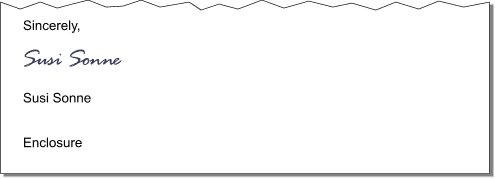

Data Analyst Cover Letter
Cover letter maker.
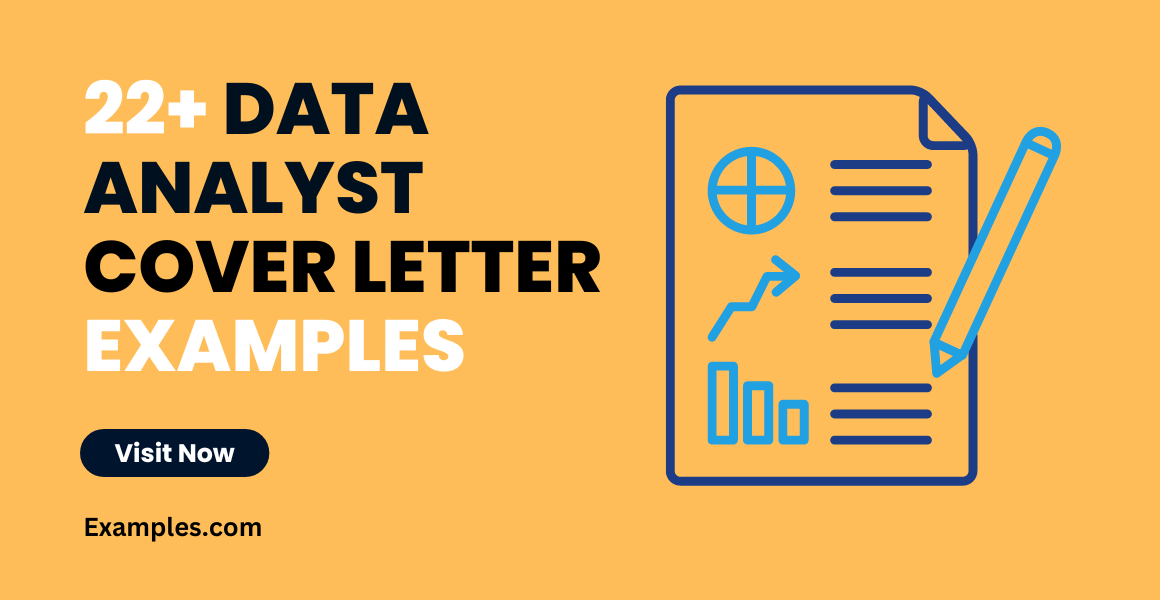
Data analysts are the gatekeepers of information in today’s digital age. Crafting an impressive cover letter for a data analyst position can be a challenging task, but it’s vital for making the right impression. In this article, we’ll uncover what a data analyst cover letter is, provide you with a standout example, and offer some useful tips to make your letter shine. Let’s dive in!
What is a Data Analyst Cover Letter?
A Data Analyst cover letter is a personalized document that accompanies a resume when applying for a data analyst position. It is tailored to the specific job, highlighting the applicant’s relevant skills, experience, and enthusiasm for the role. This good cover letter serves as an introduction, providing insight into the candidate’s abilities and why they are a perfect fit for the position. It is an opportunity to show a deep understanding of the industry and the company, emphasizing how the applicant can contribute to achieving the organization’s goals.
What is an Example of a Cover Letter for a Data Analyst?
Below is a great example of a cover letter for a data analyst position:
[Your Name] [Your Address] [City, State, ZIP] [Phone Number] [Email Address]
[Hiring Manager’s Name] [Company Name] [Company Address] [City, State, ZIP]
Dear [Hiring Manager’s Name],
I am writing to apply for the Data Analyst position at [Company Name], as advertised on [where you found the job posting]. With a strong educational background and work experience in data analytics, coupled with my passion for crunching numbers and turning raw data into actionable insights, I believe I am a suitable candidate for this role.
In my current role at [Current Employer], I have been responsible for analyzing complex datasets, identifying trends, and providing meaningful reports that have driven key business decisions. My experience with tools such as SQL, Python, and Tableau has allowed me to efficiently handle data and communicate findings to stakeholders.
I am impressed by [Company Name]’s commitment to innovation and your recent work in [mention a specific project or area you admire]. I believe that my skill set aligns perfectly with your needs, and I am excited about the opportunity to contribute to your success.
Enclosed is my resume for your review. I would welcome the chance to discuss how my expertise can match your needs in further detail. I look forward to the possibility of joining [Company Name] and thank you for considering my application.
[Your Name]
[Enclosure: Resume]
This example demonstrates a professional tone, specific skills, and alignment with the company’s values. Personalizing the letter to reflect the company’s unique characteristics and the specific job requirements will help make your application stand out.
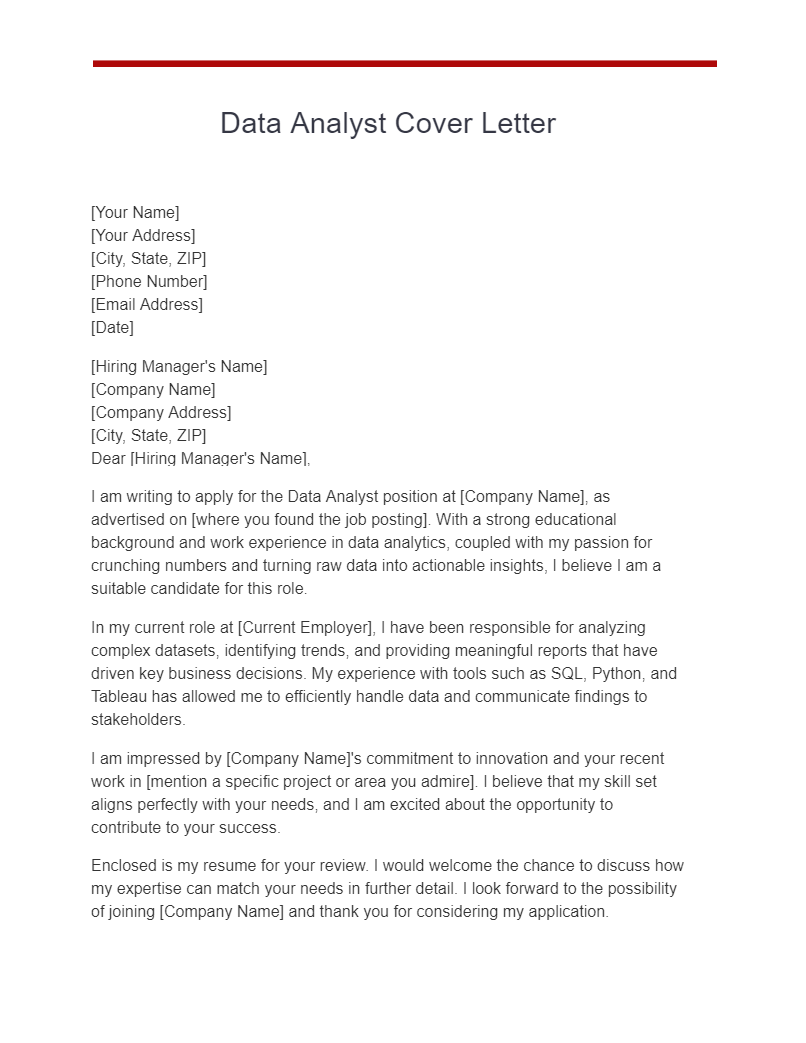
Size: 29 KB
Free Data Analyst Cover Letters – Copy & Paste
Data analyst cover letter format.
[Your Full Name] [Your Address] [City, State, ZIP] [Email Address] [Phone Number]
[Hiring Manager’s Name] [Company Name] [Address] [City, State, ZIP]
[Opening Paragraph: Introduce yourself and your intention for applying.]
[Middle Paragraph(s): Explain your relevant experience, skills, and qualifications, referencing specific aspects of the job description. Mention any relevant projects or accomplishments.]
[Closing Paragraph: Express your desire to discuss the position further and thank the reader for considering your application.]
[Your Full Name]
This format can be utilized as a foundation for any data analyst cover letter. The opening paragraph should provide a brief introduction, explaining the role you’re applying for and where you found it. In the middle paragraphs, expand on your qualifications, specific experience, and how they align with the role’s requirements. Finally, close with a statement of interest in further discussion and appreciation for their consideration.
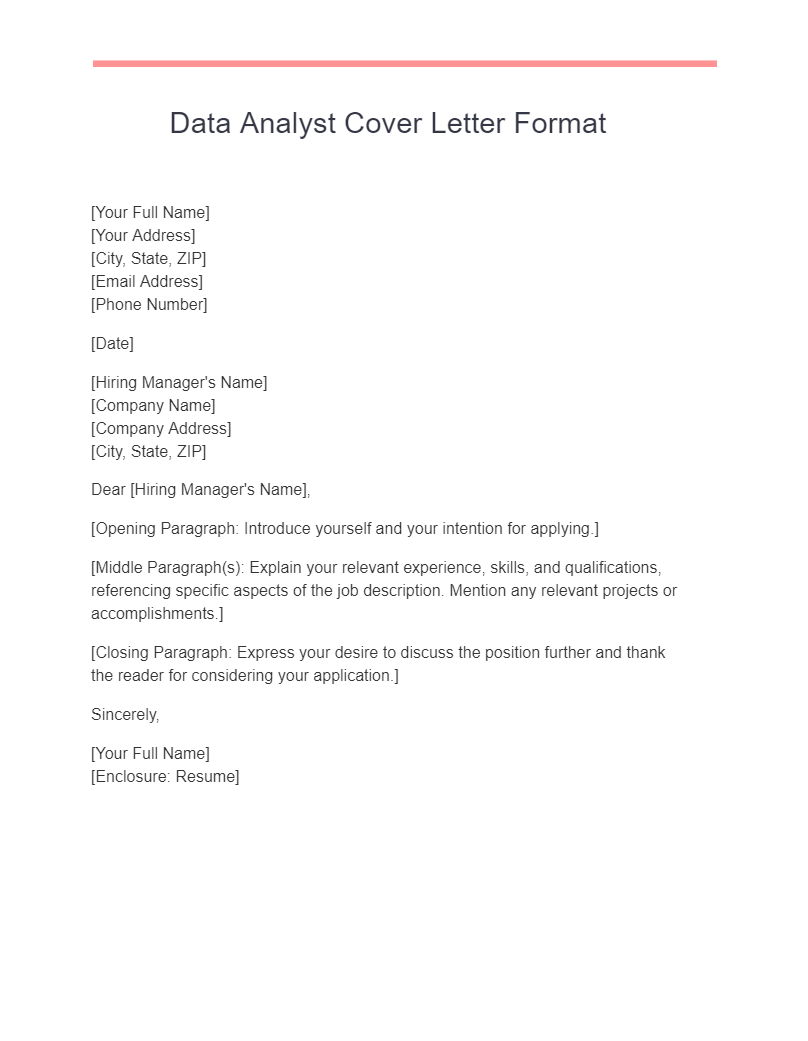
Size: 25 KB
Junior Data Analyst Cover Letter Example
[Recipient’s Name] [Company Name] [Address] [City, State, ZIP]
Dear [Recipient’s Name],
I am writing to apply for the Junior Data Analyst position at [Company Name]. With a degree in [Your Degree] and experience in [Specific Tool or Skill], I am confident that my background makes me a well-qualified candidate for this role.
At [Previous Employer], I was responsible for analyzing and interpreting data, identifying trends, and producing reports. My ability to work with complex datasets using tools like SQL and Python allowed me to contribute valuable insights to my team.
What excites me most about [Company Name] is [Mention something specific about the company]. I believe that my eagerness to learn and grow will align well with your innovative environment.
Enclosed is my resume for your review. I look forward to the possibility of contributing to [Company Name] and would be happy to discuss my qualifications in more detail.
Thank you for considering my application.
For a Junior Data Analyst position, focus on your educational background, any relevant coursework, or early career experience. Highlight your familiarity with essential tools and techniques. Make sure to convey your enthusiasm for learning and growing within the company.
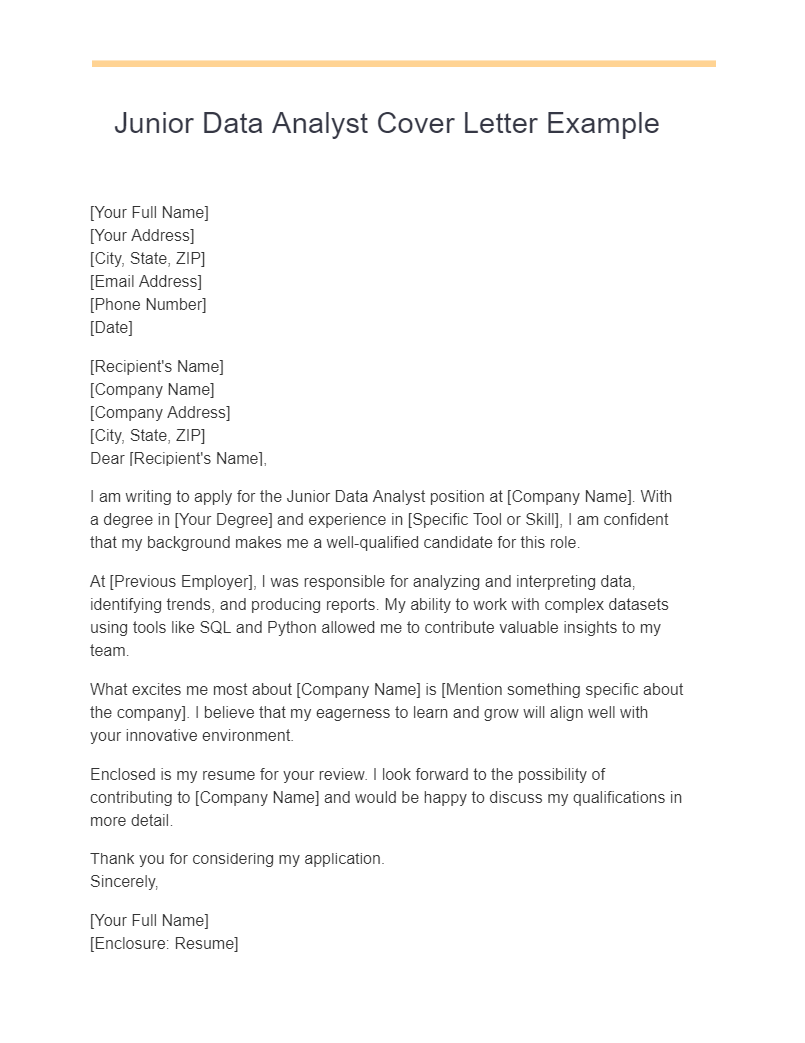
Senior Data Analyst Cover Letter Example
I am writing to express my interest in the Senior Data Analyst position at [Company Name], as advertised on [where you found the job posting]. With over [number] years of experience in the field, I have honed my skills in data modeling, statistical analysis, and leadership.
In my current role at [Current Employer], I led a team responsible for [describe a significant project or responsibility]. My expertise in tools like R, SAS, and advanced Excel functions has been key to my success in providing actionable insights.
I admire [Company Name]’s commitment to [mention something specific about the company] and believe that my experience and strategic thinking would make me a valuable asset to your team.
I have enclosed my resume for your review and would welcome the opportunity to discuss how my skills and experiences align with your needs.
A Senior Data Analyst cover letter should focus on extensive experience, leadership roles, and significant accomplishments. Detail your proficiency with advanced tools and methodologies, and tailor your letter to reflect the company’s specific needs and culture.
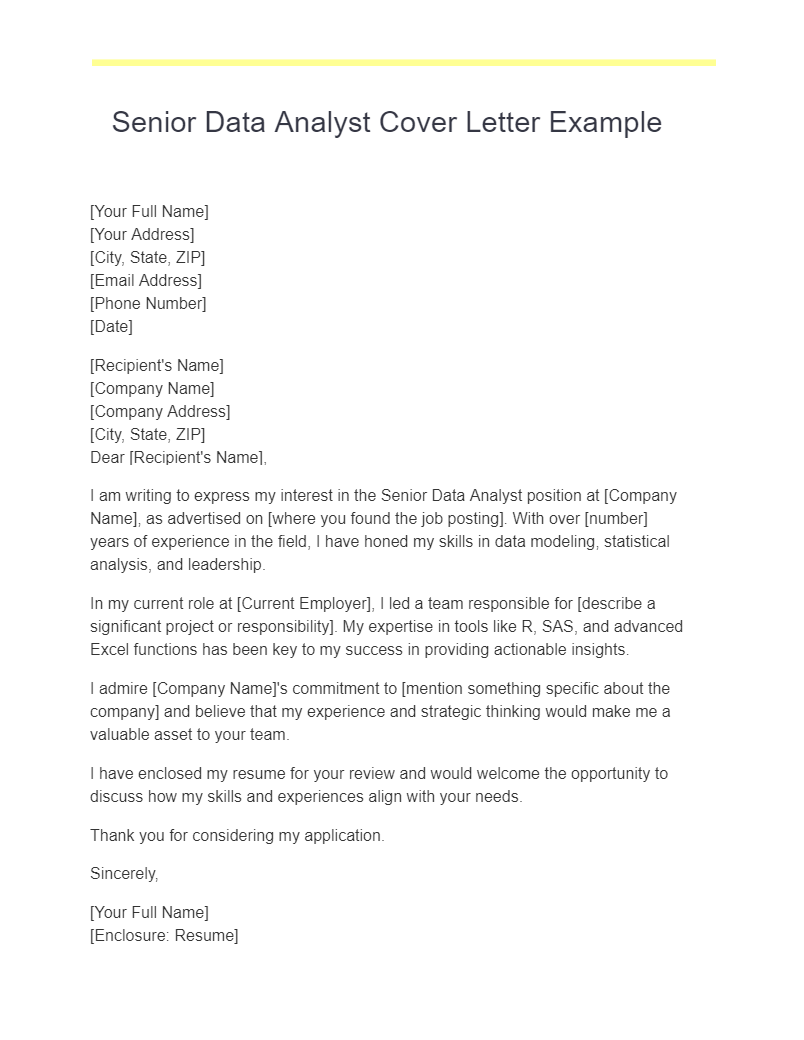
Size: 27 KB
Entry Level Data Analyst Cover Letter Example
I recently graduated from [University Name] with a degree in [Your Degree], and I am eager to start my career as an Entry Level Data Analyst at [Company Name]. Though I am new to the professional field, my academic background and internship experience have provided me with valuable skills in data analysis.
During my internship at [Previous Internship], I had the opportunity to work with real-world data, utilizing tools like Excel and PowerBI to interpret and visualize information. My ability to translate complex data into understandable insights would enable me to contribute effectively to your team.
What draws me to [Company Name] is your commitment to [mention something specific about the company]. I believe that this aligns well with my aspirations, and I am excited about the opportunity to grow within your organization.
I have enclosed my resume for your consideration and look forward to discussing how I can add value to [Company Name].
For an Entry Level position, concentrate on your educational background, internships, and relevant coursework. Emphasize your eagerness to learn and your alignment with the company’s values.
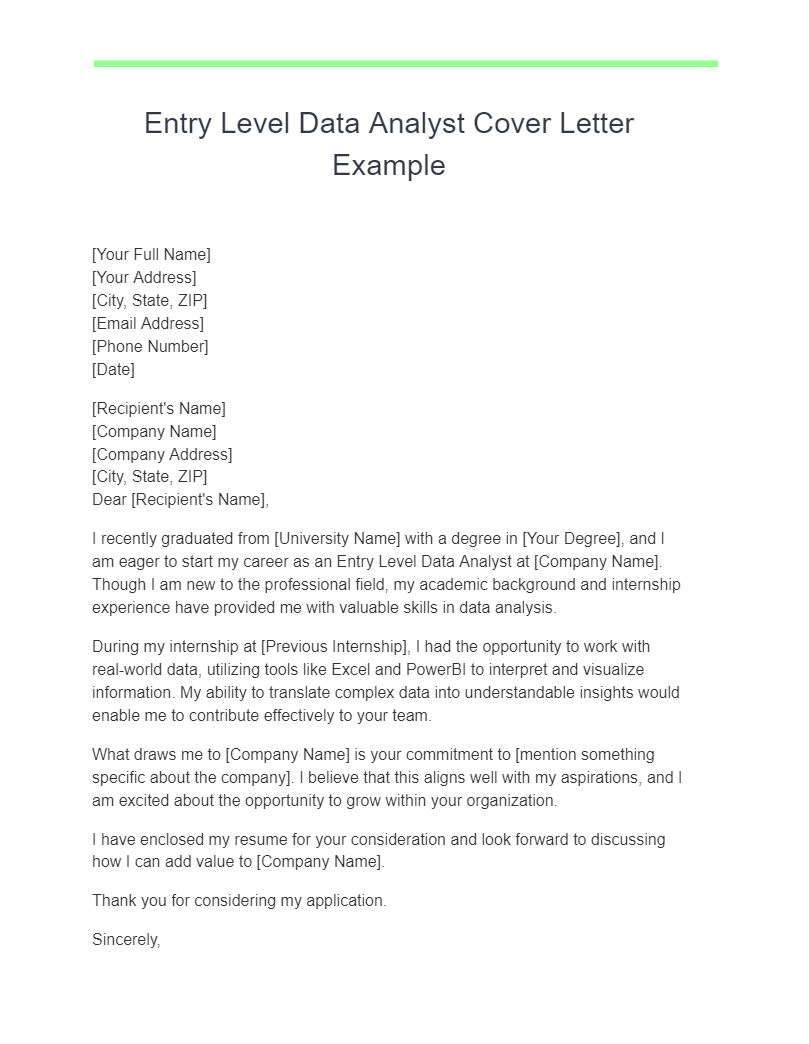
Data Analyst Cover Letter without / No Experience Example
I am writing to apply for the Data Analyst position at [Company Name]. Though I lack direct experience in data analysis, my educational background in [Your Field or Degree], transferable skills, and passion for understanding data make me a strong candidate for this role.
During my studies, I developed skills in quantitative reasoning, critical thinking, and problem-solving. I have also familiarized myself with basic data analysis tools through self-study and online courses.
I am drawn to [Company Name] because of [mention something specific about the company]. Your focus on innovation and growth resonates with my ambitions, and I am eager to contribute my unique perspective and willingness to learn.
Enclosed is my resume for your review, and I would be pleased to discuss how my skills and potential align with your needs.
When writing a cover letter with no direct experience , focus on transferable skills, relevant coursework, and personal enthusiasm for the field. Express your willingness to learn and how your unique background can contribute to the company.
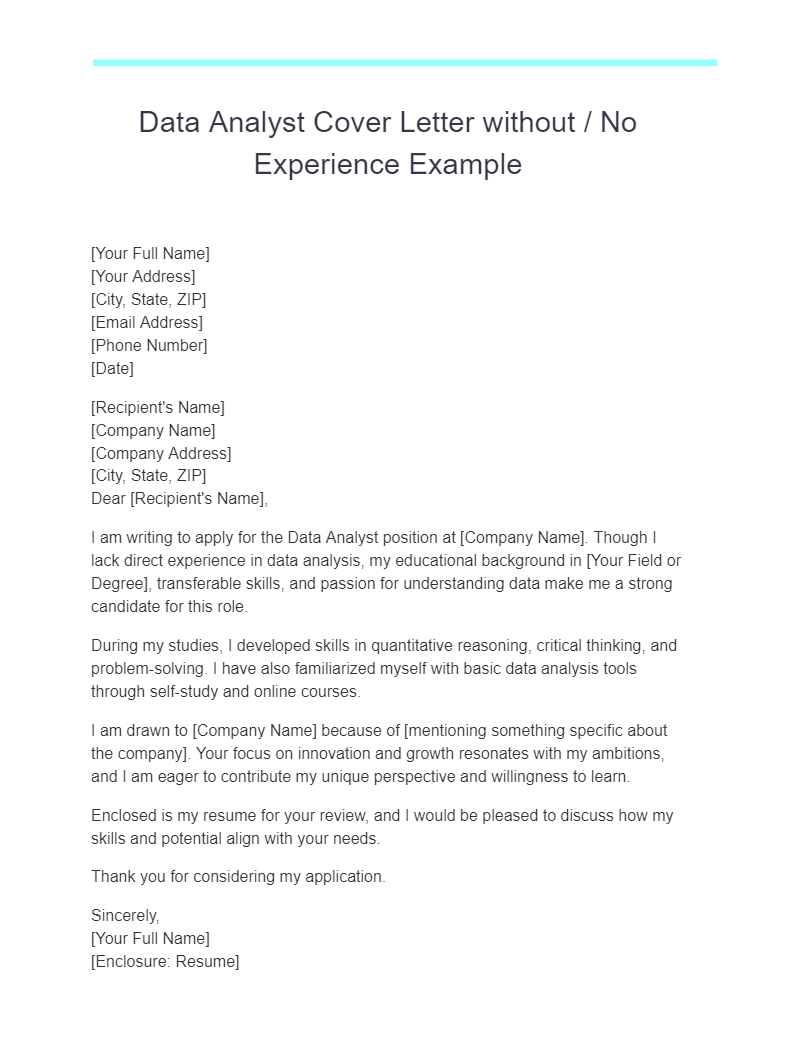
Size: 26 KB
Data Analyst Cover Letter for Upwork Example
[Your Full Name] [Email Address] [Phone Number]
[Client’s Name] [Project Title]
Dear [Client’s Name],
I recently came across your posting for a Data Analyst on Upwork, and I am thrilled to offer my services for this project. With [number] years of experience in data analysis, I possess the right blend of technical skills and analytical prowess to meet your requirements.
In my previous remote work, I successfully collaborated with clients to understand their data needs, analyze trends, and deliver actionable insights. My proficiency with tools such as Python, SQL, and PowerBI ensures that I can handle various data tasks efficiently.
I am particularly excited about [specific aspect of the project], as it aligns with my expertise in [mention relevant experience or skill]. I believe that my ability to work independently, communicate effectively, and adhere to deadlines makes me an ideal fit for this project.
Enclosed are samples of my previous work and my Upwork profile for your review. I am available for a discussion at your convenience to delve into how I can contribute to the success of this project.
Thank you for considering my proposal.
[Enclosure: Portfolio, Upwork Profile]
When writing a cover letter for Upwork, it’s crucial to focus on your relevant skills, previous remote work experience, and ability to meet the specific requirements of the client’s project. Personalize your letter to align with the project details and provide evidence of your success in similar roles.
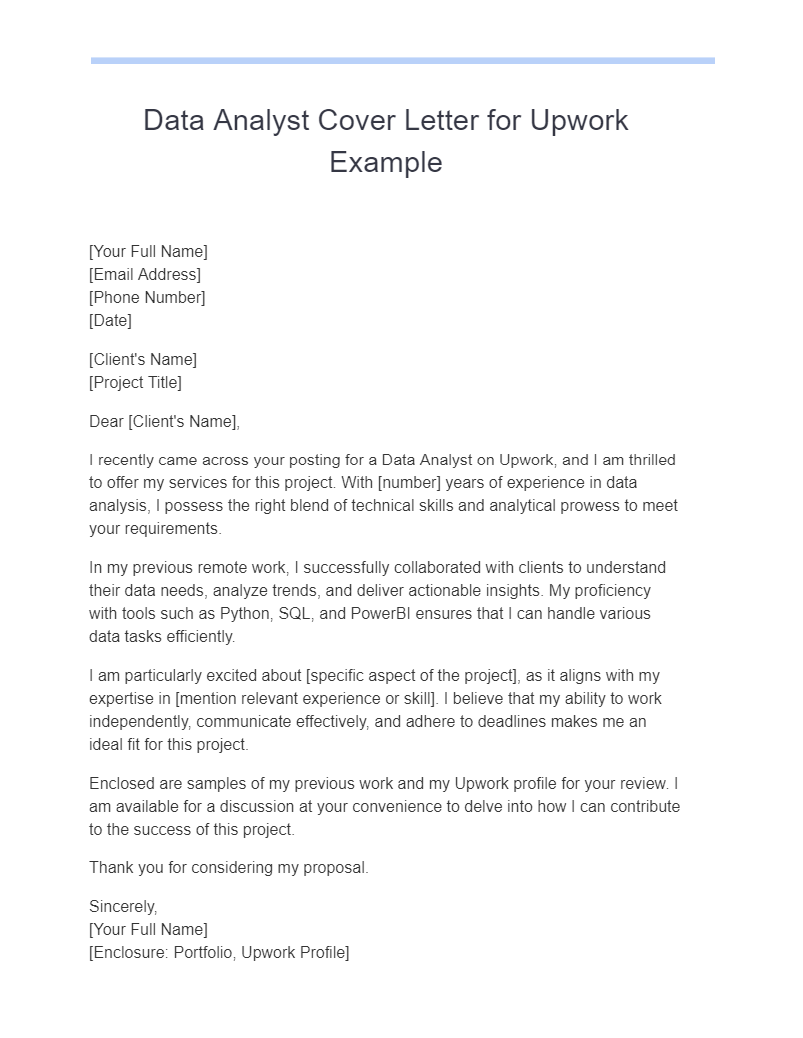
Size: 28 KB
Data Analyst Cover Letter for Internship Example
I am writing to apply for the Data Analyst Internship at [Company Name], which I found on [where you found the internship posting]. As a [Your Major] major at [University Name], I have developed a strong foundation in data analysis, statistics, and programming, making me well-prepared for this opportunity.
During my academic projects, I have worked with real-world datasets, utilizing tools like R and Excel to interpret, analyze, and visualize data. My ability to work in a team, coupled with my eagerness to learn and apply new concepts, would enable me to thrive in this internship.
I am particularly impressed by [Company Name]’s work in [mention specific project or area you admire]. This aligns with my interest in [specific interest related to data analysis], and I believe I can contribute fresh perspectives and insights.
I have enclosed my resume for your review, and I am available to discuss my qualifications in more detail. Thank you for considering my application.
In Internship cover letter , emphasize your relevant coursework, academic projects, and eagerness to learn. Focus on how your skills align with the internship’s requirements and express genuine interest in the company’s work.

Sample Data Analyst Cover Letter Example
I am writing to apply for the Data Analyst position at [Company Name]. With [number] years of experience in the field, I have developed strong analytical skills, proficiency in key data tools, and a deep understanding of how data can drive business decisions.
In my current role at [Current Employer], I have been instrumental in [mention a significant accomplishment or project], utilizing tools like SAS, Python, and Tableau to interpret complex data and provide actionable insights.
I admire [Company Name]’s focus on [mention something specific about the company], and I believe that my expertise in [specific area of data analysis] would complement your team’s efforts.
Enclosed is my resume for your review. I look forward to discussing how my experience and skills can contribute to [Company Name]’s continued success.
This sample letter is adaptable to various data analyst roles. Focus on your relevant experience, key accomplishments, and alignment with the company’s goals. Tailor the content to reflect the specific job description and company culture.
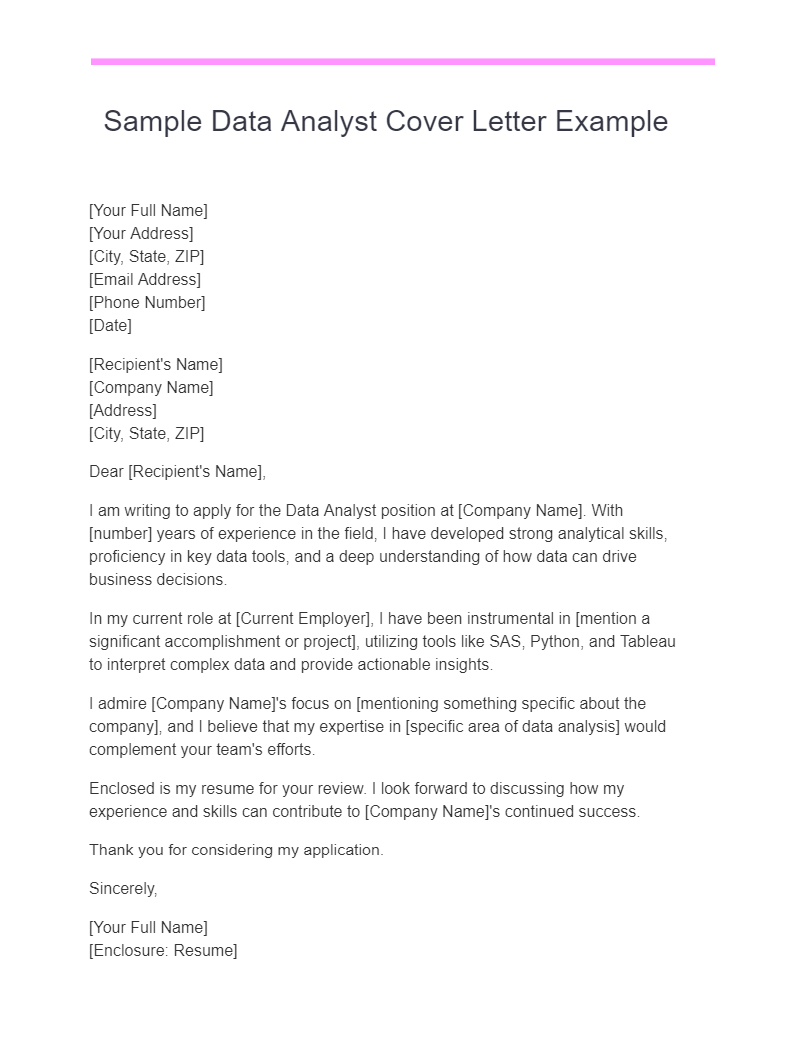
Fresh Graduate Data Analyst Cover Letter Example
I recently graduated from [University Name] with a degree in [Your Degree], and I am eager to launch my career as a Data Analyst at [Company Name]. My educational background, coupled with my passion for data and analytics, makes me an ideal candidate for this role.
During my studies, I completed projects involving [mention specific tools or methodologies], which provided hands-on experience in data interpretation, visualization, and problem-solving. My ability to work both independently and in collaborative settings would enable me to adapt quickly to your team.
I am drawn to [Company Name] because of your work in [mention something specific about the company], and I believe that I can contribute fresh insights and creativity.
Enclosed is my resume for your consideration. I look forward to discussing how I can add value to [Company Name]’s innovative efforts.
In fresh graduate cover letter , focus on your educational background, relevant projects, and willingness to learn. Express genuine interest in the company and the specific role.
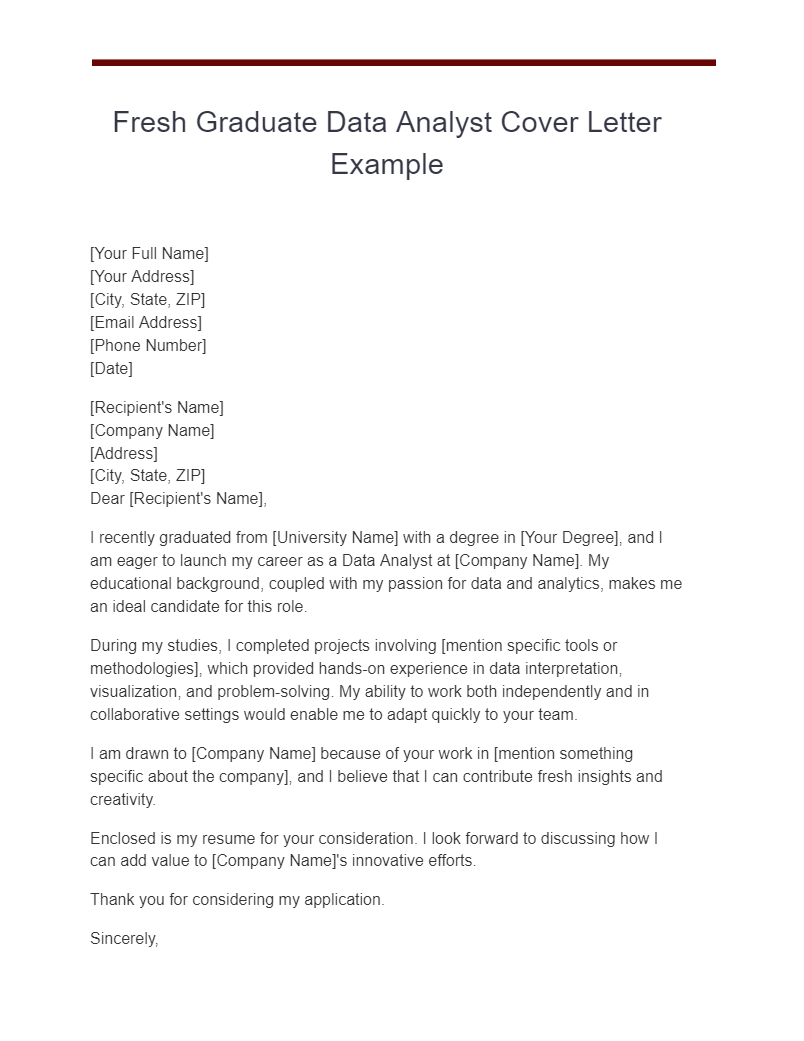
Fresher Data Analyst Cover Letter Example
I am writing to apply for the Data Analyst position at [Company Name]. As a fresher in this field, I bring a unique blend of academic knowledge, enthusiasm for data, and readiness to contribute to your team.
My recent completion of a degree in [Your Degree] has equipped me with key skills in statistical analysis, data mining, and machine learning. I have also completed certifications in tools like SQL and Python, demonstrating my commitment to expanding my technical skills.
I am particularly impressed by [Company Name]’s achievements in [mention something specific about the company], and I believe that my fresh perspective and eagerness to learn would align well with your
innovative culture.
Enclosed is my resume for your review. I welcome the opportunity to discuss how I can contribute to your team’s success.
For those new to the field (fresher), In fresher cover letter it is essential to highlight your academic achievements, certifications, and eagerness to learn. Show that you are aligned with the company’s values and mission.
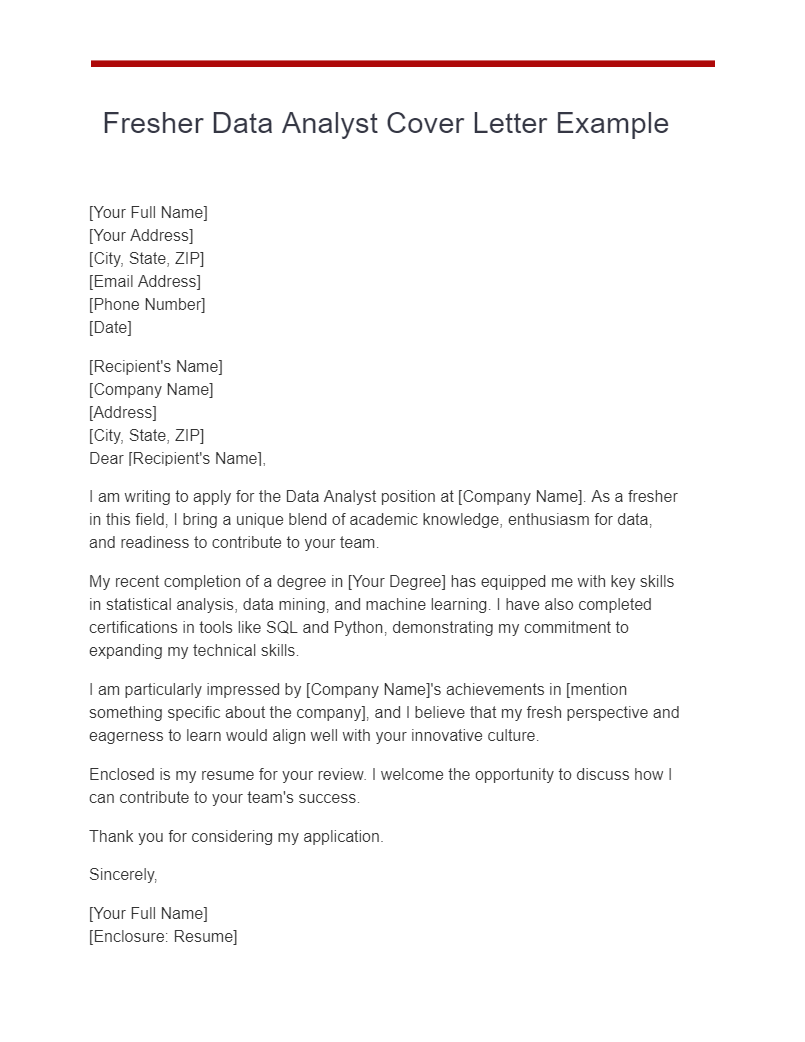
Student Data Analyst Cover Letter Example
As a student majoring in [Your Major] at [University Name], I am writing to apply for the Student Data Analyst position at [Company Name]. My academic pursuits and hands-on experience in data analysis have equipped me with the skills necessary to excel in this role.
I have participated in various university projects, utilizing Python, R, and Excel to analyze data, draw insights, and present findings. My ability to collaborate with team members, combined with my attention to detail, has been instrumental in successfully completing these projects.
I am drawn to [Company Name] for its commitment to [specific area or project that attracts you], and I believe that my student perspective would add a unique dimension to your team.
Enclosed is my resume for your review. I look forward to discussing how my academic experience and passion for data can contribute to your organization.
In a Student cover letter , focusing on academic experiences and university projects is vital. Express enthusiasm for the role and how your skills as a student can add value to the company.
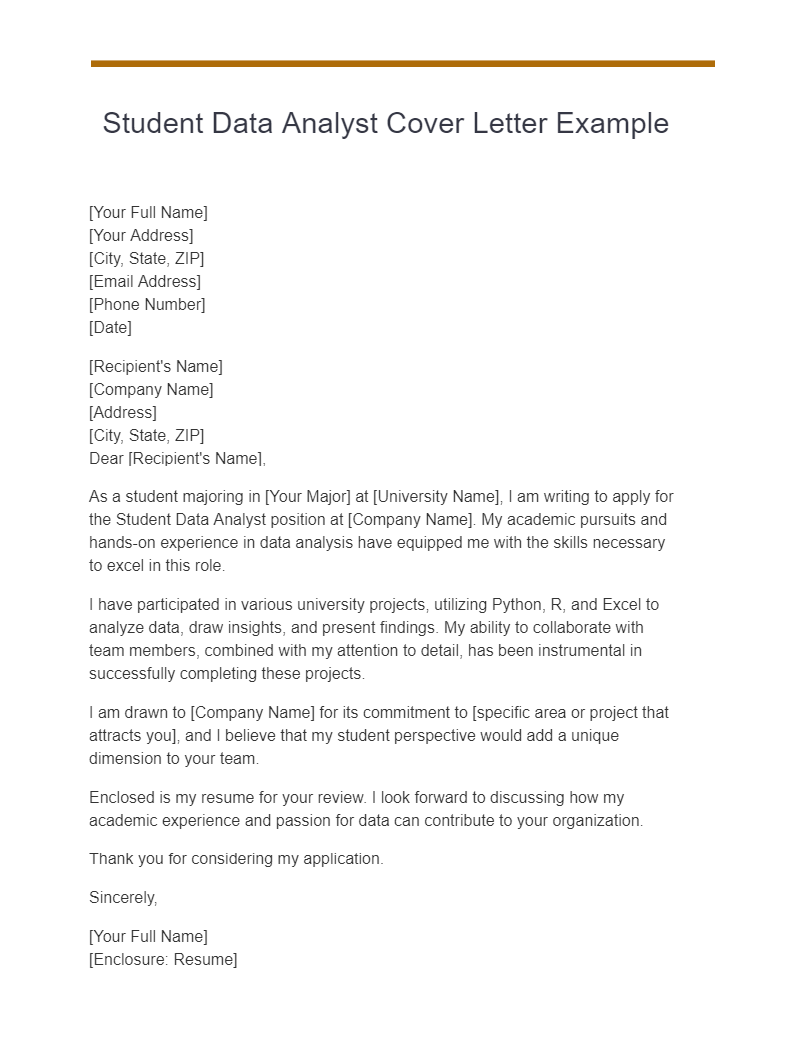
Cover Letter for Data Science Role Example
I am writing to apply for the Data Scientist position at [Company Name]. With a strong background in data analysis, machine learning, and statistical modeling, I am confident in my ability to generate superior results for your team.
At [Current Employer], I have led projects that required deep data analysis, predictive modeling, and algorithm development. Using tools such as TensorFlow, Python, and R, I was able to drive improvements in [mention specific results or area].
I admire [Company Name]’s work in [specific project or field], and I see a great opportunity to apply my expertise in data science to enhance your operations.
Enclosed is my resume, and I look forward to the opportunity to discuss how my extensive skills and experience can benefit [Company Name].
A cover letter for a data science role should highlight expertise in areas like machine learning, predictive modeling, and advanced statistical techniques. Emphasize how your specific skills align with the company’s projects and goals.
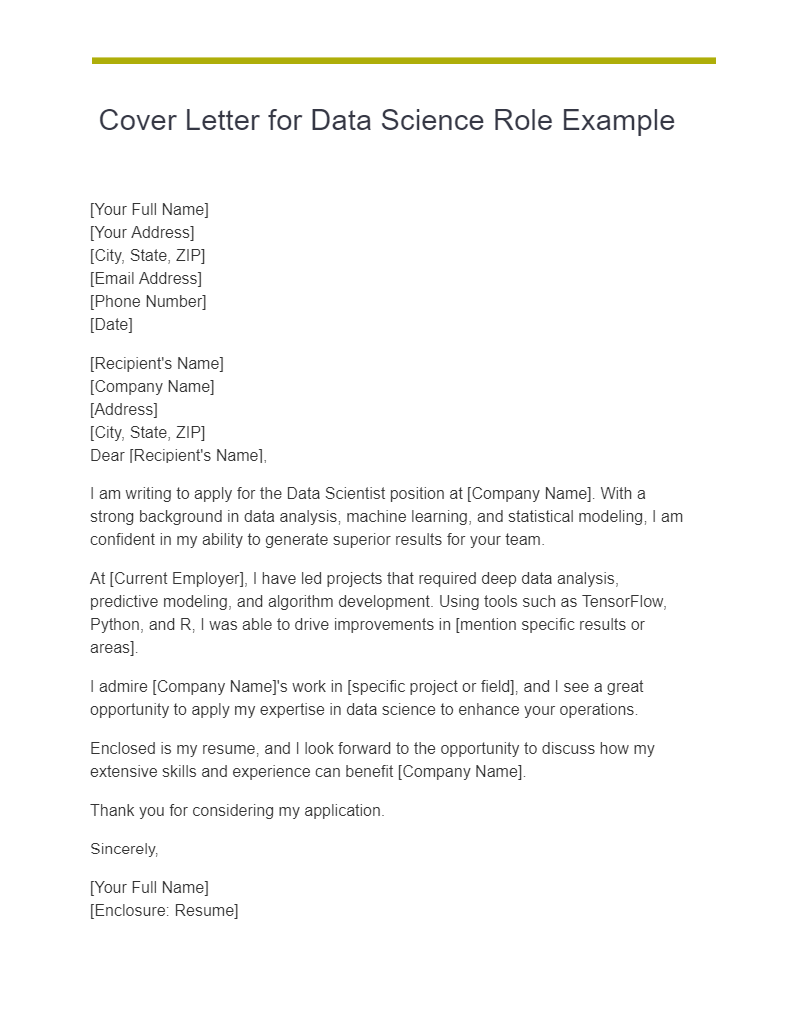
Data Analyst Cover Letter for Resume Example
I am excited to apply for the Data Analyst position at [Company Name]. My comprehensive resume, enclosed with this letter, outlines my substantial experience and qualifications in data analysis, visualization, and reporting.
In my current role at [Current Employer], I have consistently delivered high-quality analysis using tools like SQL, Power BI, and Excel. My ability to translate complex data into actionable insights has contributed to [specific accomplishment or business success].
What sets me apart is my passion for understanding the story behind the data and how it can shape and drive business strategies. I believe my unique blend of technical skills and business acumen would make me a valuable asset to [Company Name].
I look forward to the opportunity to further discuss my qualifications and how I can contribute to the growth and success of your team.
This general resume cover letter can accompany a resume for a data analyst role. Focus on your ability to use data to drive decision-making, and highlight any tools or specific achievements relevant to the position.
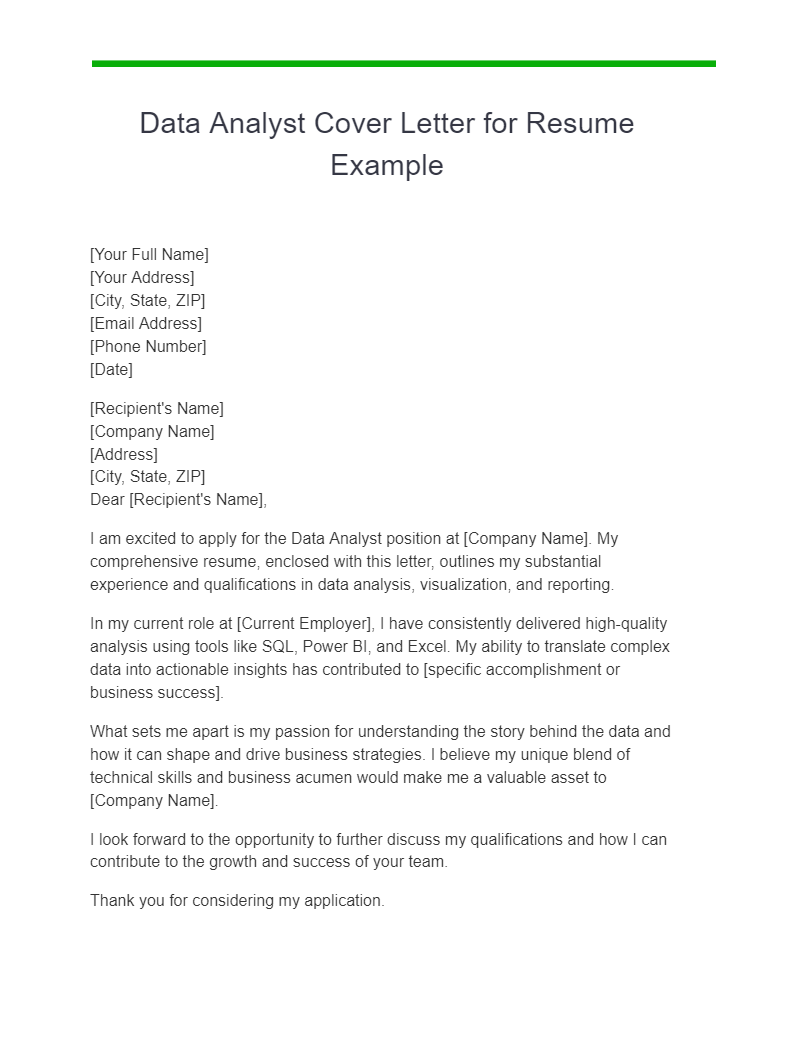
Data Analyst Cover Letter for Financial Services Example
[Recipient’s Name] [Financial Company Name] [Address] [City, State, ZIP]
I am writing to apply for the Data Analyst position at [Financial Company Name]. With my experience in financial data analysis, statistical modeling, and risk management, I believe I am well-suited for this role.
Having worked in the financial sector for [number] years, I have developed strong expertise in using tools like SAS, MATLAB, and SQL to analyze financial trends, evaluate investment opportunities, and deliver insights that inform strategic decisions.
I admire [Financial Company Name]’s commitment to innovation and integrity, and I am eager to contribute my skills to enhance your financial analysis and decision-making processes.
Enclosed is my resume for your review, and I look forward to discussing how my specialized experience in financial services can add value to your team.
When targeting a role in financial services, emphasize your familiarity with financial data analysis, risk management, and relevant tools. In Finance Cover Letter , Highlight how your experience aligns with the company’s needs and values.
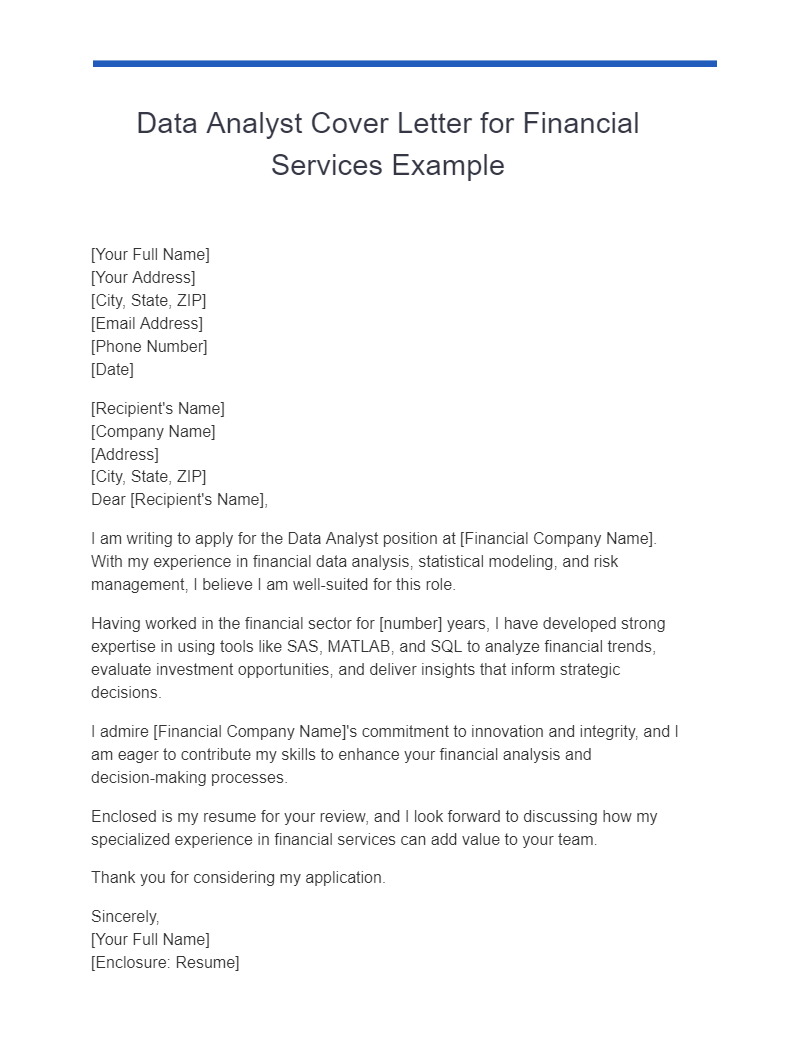
SQL Data Analyst Cover Letter Example
I am writing to apply for the SQL Data Analyst position at [Company Name]. My extensive experience in SQL, database management, and data extraction uniquely qualifies me for this role.
In my previous role at [Former Employer], I successfully managed large SQL databases, optimized queries, and provided data-driven insights that led to [mention specific outcomes or improvements].
My expertise in SQL, combined with my ability to communicate complex data findings in an understandable manner, makes me confident that I can contribute significantly to [Company Name]’s data analysis efforts.
Enclosed is my resume, and I look forward to discussing how my specialized skills in SQL can support your team’s objectives.
When applying for a role that specifically requires SQL skills, focus on your experience with managing SQL databases, writing queries, and using SQL for data analysis. Provide examples of how you have used SQL to achieve tangible results.
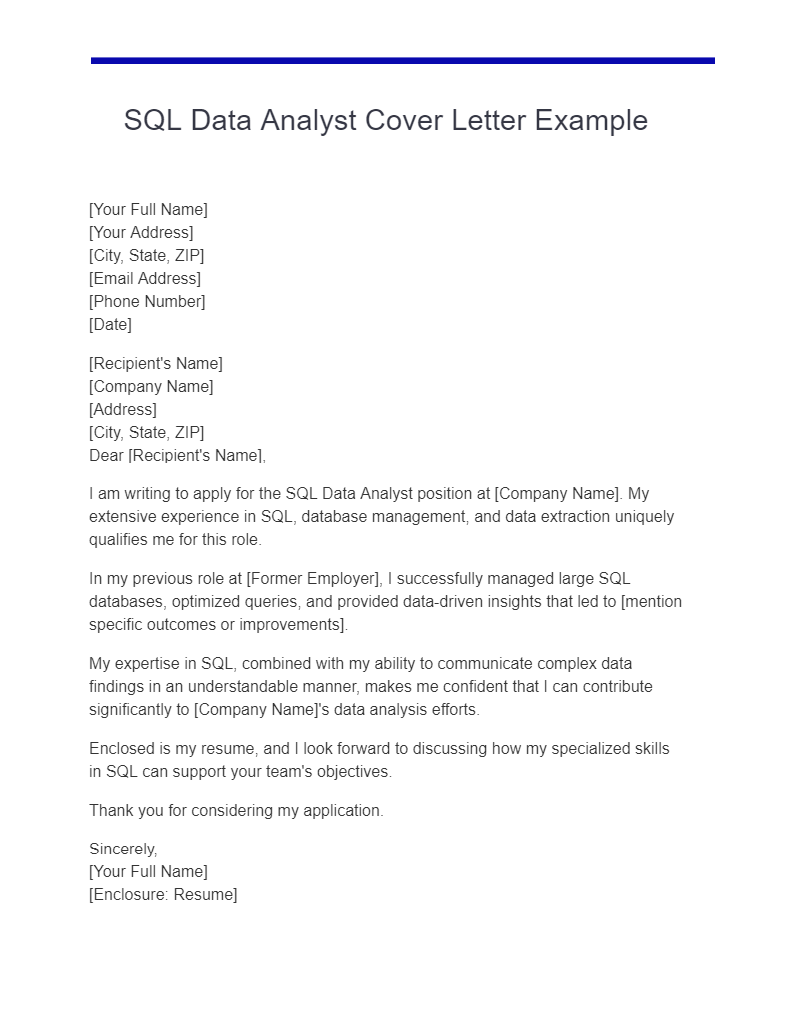
Short Data Analyst Cover Letter Example
I am writing to apply for the Data Analyst position at [Company Name]. With a background in data analysis using tools like SQL, Excel, and Tableau, I have successfully transformed data into actionable insights.
I am particularly drawn to [Company Name] for its commitment to innovation. I believe that my unique skill set, coupled with my passion for data-driven decision-making, would make me a valuable asset to your team.
Thank you for considering my application. I look forward to the opportunity to discuss further.
A short cover letter must be concise yet impactful. Focus on your key qualifications and express genuine interest in the company’s mission or projects. Tailor your content to match the specific role.

Data Analyst Cover Letter for Job Application Example
I am thrilled to submit my application for the Data Analyst position at [Company Name]. With [number] years of experience in data analysis, I have honed my abilities in statistical analysis, data visualization, and business intelligence.
At [Current Employer], I have played a key role in leveraging data to drive business improvement. Through my expertise in tools like Python, R, and Power BI, I have been able to contribute to [specific accomplishment or business success].
I am eager to bring my analytical acumen and collaborative spirit to [Company Name], and I believe I can make a significant contribution to your team’s success.
Enclosed is my resume for your review, and I look forward to discussing how my skills can benefit [Company Name].
This example is suited for a general job application. Emphasize your experience, tools you’ve used, and how your skills can align with the company’s goals. Personalize it according to the specific role and company.
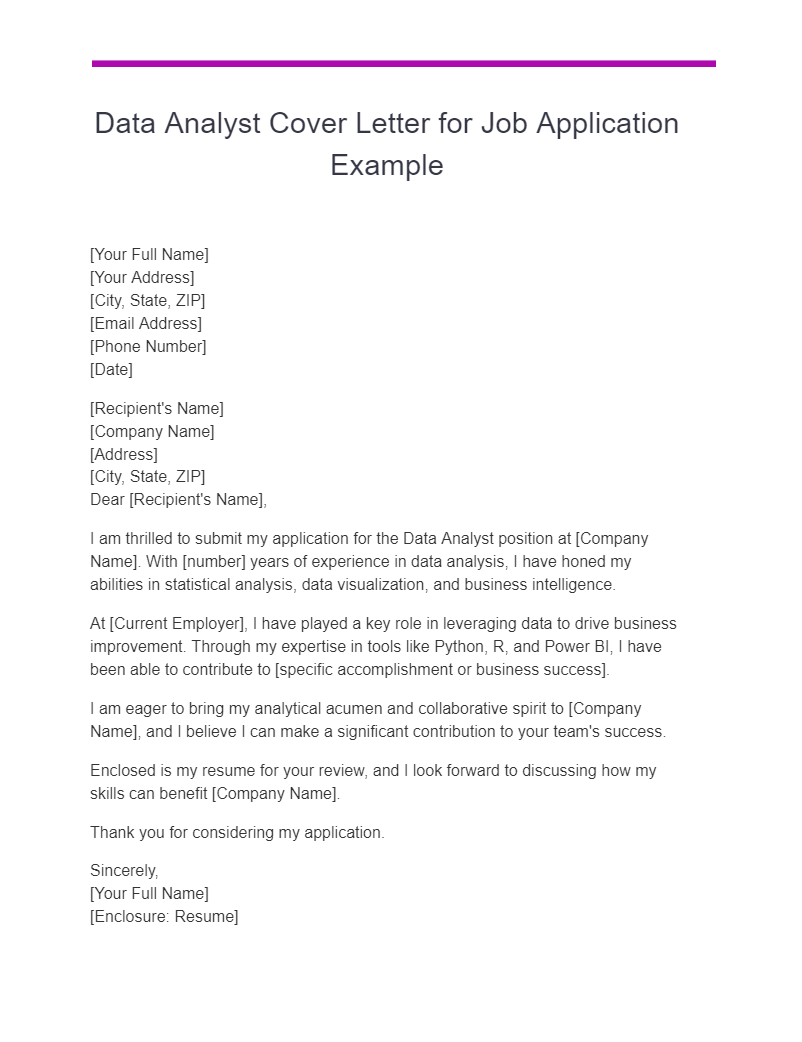
Medical Data Analyst Cover Letter Example
[Recipient’s Name] [Healthcare Organization] [Address] [City, State, ZIP]
I am writing to apply for the Medical Data Analyst position at [Healthcare Organization]. My experience in healthcare data analysis, coupled with my knowledge of medical terminologies and statistical methods, makes me an ideal candidate for this role.
Working with [Previous Healthcare Employer], I utilized tools like SAS and SQL to analyze clinical data, improve patient care quality, and support healthcare decision-making.
I am drawn to [Healthcare Organization]’s dedication to patient-centered care, and I am eager to contribute my skills in data analysis to further this mission.
Enclosed is my resume for your review, and I look forward to the opportunity to discuss how my specialized experience in medical data can support your organization.
In Medical cover letter , highlight your experience with healthcare data, familiarity with clinical terms, and how your skills can contribute to patient care and organizational goals.

Data Analyst Reporting Cover Letter Example
I am writing to apply for the position of Data Analyst with a focus on reporting at [Company Name]. With an extensive background in data analytics and reporting, I am adept at transforming complex data sets into clear and actionable reports.
In my current role at [Current Employer], I have developed and maintained dynamic reports using tools like Tableau, Excel, and SQL. My ability to communicate data insights through visualizations and concise narratives has greatly influenced [specific business decisions or strategy].
I admire [Company Name]’s commitment to [specific area or project that attracts you], and I am eager to contribute my reporting expertise to enhance your data-driven decision-making.
Enclosed is my resume for your review. I look forward to discussing how my specialized skills in data reporting can support your team’s objectives.
When applying for a role focused on reporting, emphasize your ability to create meaningful reports, use various reporting tools, and communicate data insights. Showcase how your skills have impacted business decisions or strategies.
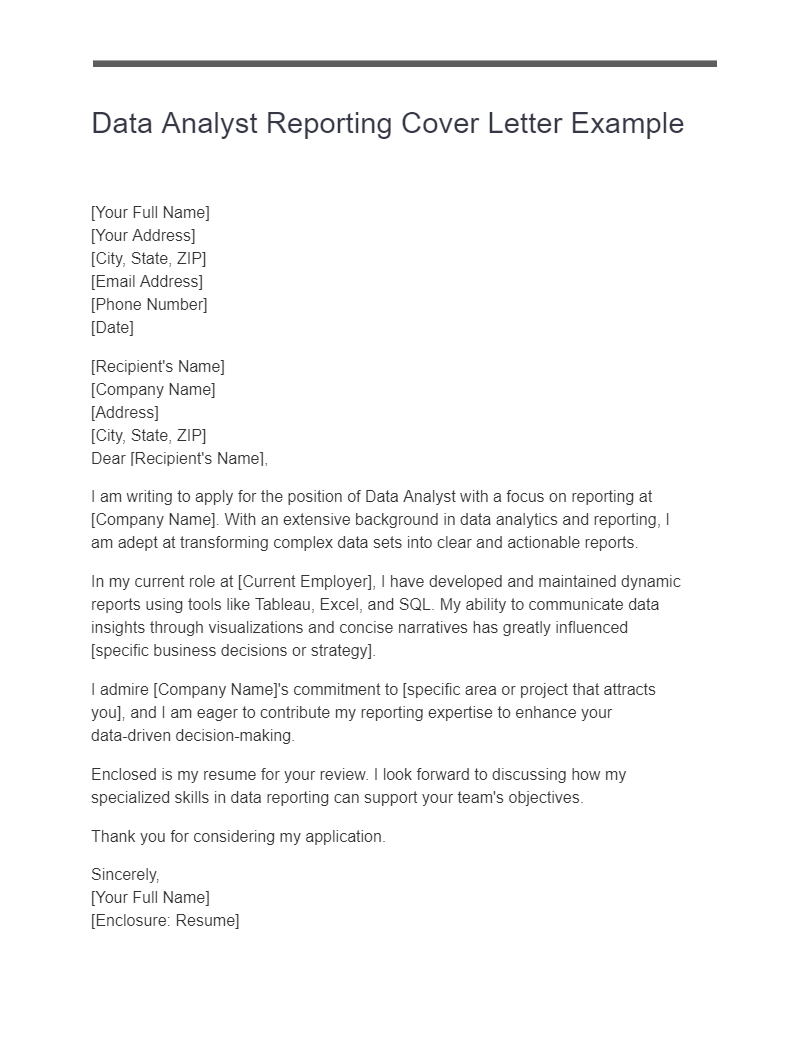
Research Analyst Cover Letter Example
I am writing to apply for the Research Analyst position at [Company Name], as advertised on [where you found the job posting]. With a strong educational background and work experience in research, coupled with my passion for contributing to a company with a solid track record, I believe I am a suitable candidate for this role.
During my tenure at [Previous Employer], I honed my analytical skills, working closely with different departments to conduct comprehensive research and analysis on various industry trends and competitive markets. My expertise in utilizing software like SPSS, R, and Excel has allowed me to deliver insightful reports and presentations that influenced key business strategies.
What excites me most about the opportunity at [Company Name] is your commitment to innovative research methods and collaboration across different business units. Your recent project on [specific project or area of interest] resonates with my professional philosophy and career goals.
In the attached resume, you will find more details about my experience in research methodology, data collection, analysis, and reporting. I believe that my ability to work with cross-functional teams, along with my strong communication and analytical skills, aligns with what you are looking for in a Research Analyst.
Thank you for considering my application. I look forward to the opportunity to discuss my candidacy further.
For a Research Analyst cover letter, focus on your analytical abilities, research experience, tools you’ve used, and how you have influenced decision-making. Mention any specific industry or research area that aligns with the company’s focus.
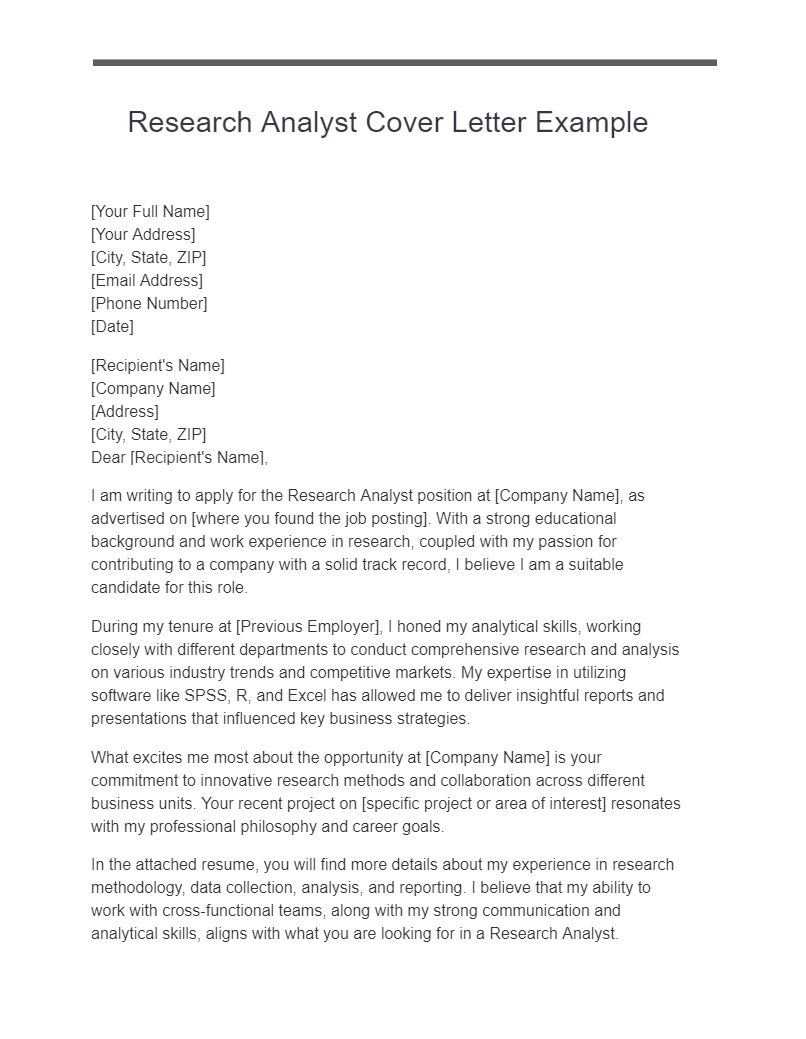
Data Scientist Cover Letter Example
I am reaching out to apply for the Data Scientist role at [Company Name], a position that perfectly aligns with my educational background and professional experience. As a data scientist with over [number] years of experience in machine learning, statistical modeling, and data visualization, I am confident in my ability to generate superior results for your team.
Currently, I work at [Current Employer], where I handle a wide range of data science tasks, including predictive modeling, algorithm development, and big data analytics using tools such as Python, R, TensorFlow, and Hadoop. My work has led to a [specific achievement or improvement in a business aspect].
What draws me to [Company Name] is your work in [specific area or project], and I see an opportunity to apply my expertise to further enhance and innovate in this area. Your commitment to using data-driven strategies to drive business goals is a perfect match for my professional objectives.
In my attached resume, you will find detailed information about my technical skills, accomplishments, and contributions to past employers. I am eager to bring my strong work ethic, technical prowess, and passion for data science to [Company Name].
I appreciate your consideration and look forward to discussing how I can contribute to the success of your esteemed company.
For a Data Scientist cover letter, emphasize your technical skills in machine learning, big data, programming languages, and how your work has influenced the business. Reference any specific area or project that aligns with the company’s focus.
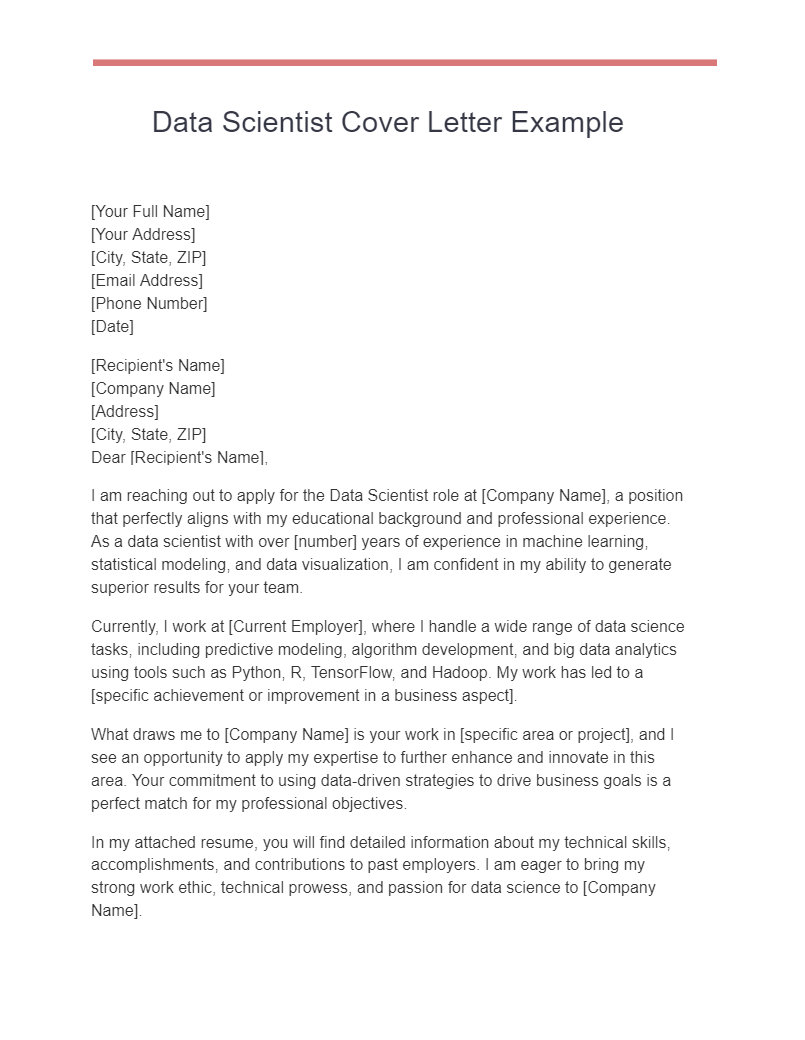
Market Data Analyst Cover Letter Example
I am excited to apply for the Market Data Analyst position at [Company Name]. With my extensive background in market research and data analysis, I believe I am well-suited to support your team in delivering data-driven insights to drive business strategies.
At [Previous Employer], I conducted comprehensive market analysis using various tools like SQL, Tableau, and Excel. I closely monitored market trends, competitors’ performance, and customer behaviors, translating complex data into actionable insights and recommendations. My work significantly contributed to the development of new products and marketing strategies, leading to a [specific achievement or business growth].
Your company’s reputation for leveraging market data to inform business decisions is both inspiring and aligned with my career aspirations. I am particularly interested in your recent work on [specific project or market], and I believe my unique skill set would be a valuable asset to your team.
Please find my resume attached, outlining my qualifications and professional accomplishments. I look forward to the opportunity to discuss how my experience in market data analysis can contribute to the continued success of [Company Name].
For a Market Data Analyst cover letter, highlight your ability to analyze market trends, competitors, and consumer behavior. Showcase how your analysis has contributed to business decisions, product development, or marketing strategies. Reference any specific area or project that aligns with the company’s focus.
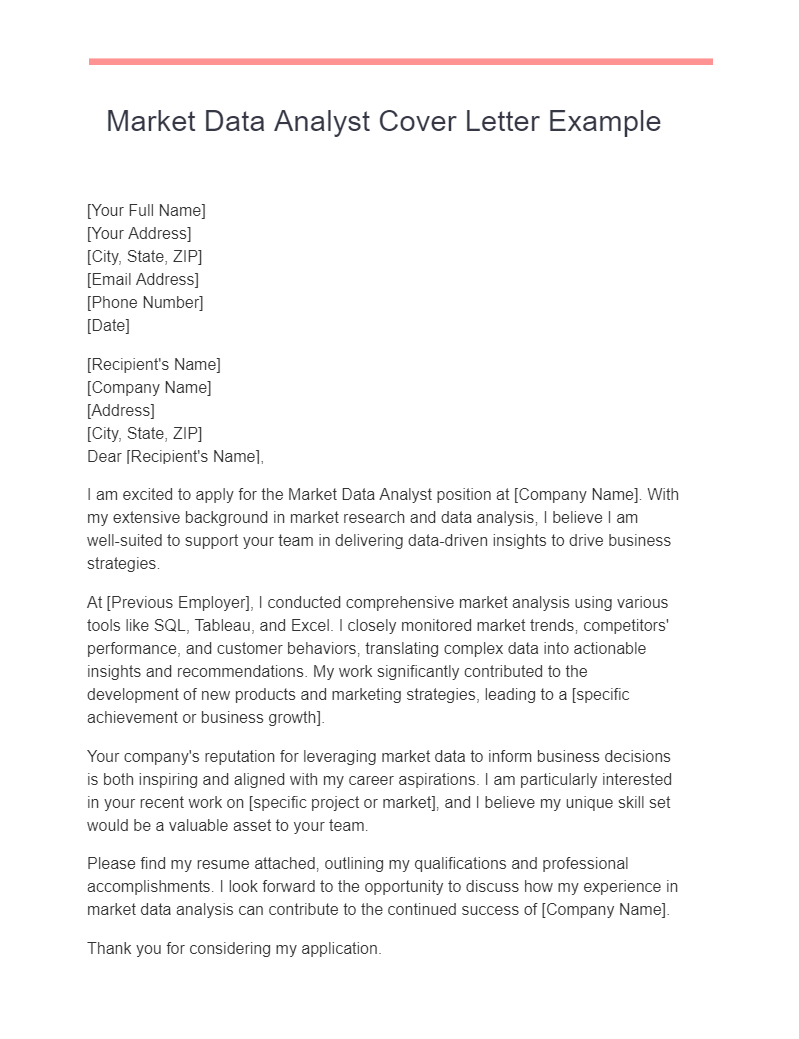
Simple Data Analyst Cover Letter Example
I am writing to apply for the Data Analyst position at [Company Name]. With a strong foundation in statistics, data mining, and business intelligence, I am confident in my ability to make a meaningful contribution to your team.
In my current role at [Current Employer], I have had the opportunity to work on various data analysis projects, utilizing tools like SQL, Python, and Excel. I pride myself on my ability to interpret complex data and translate it into clear and actionable insights that drive business growth.
I am impressed by [Company Name]’s commitment to innovation and data-driven decision-making. I believe my skills and experience align perfectly with what you are seeking in a Data Analyst.
Enclosed is my resume for your review. I look forward to discussing how I can contribute to your team’s success.
A Simple cover letter should focus on your core skills in data analysis, tools you have used, and how your work has supported business growth. Keep it concise and tailored to the specific company and role.
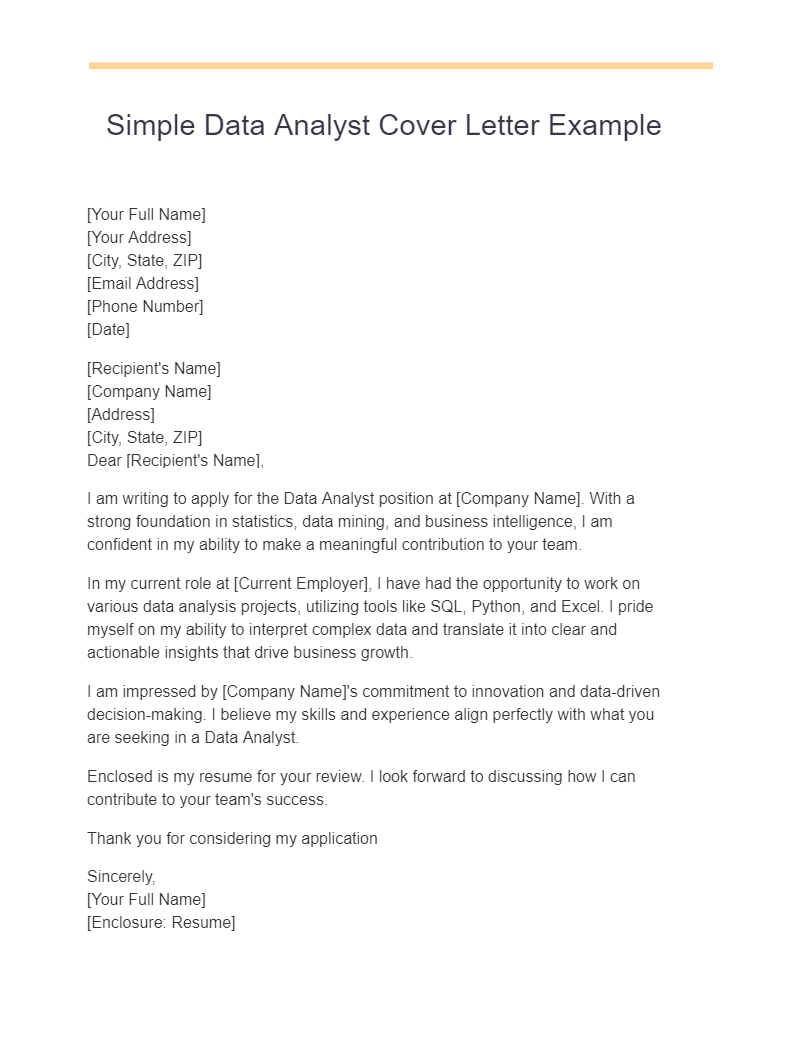
Basic Data Analyst Cover Letter Example
I am writing to express my interest in the Data Analyst position at [Company Name]. My background in data analysis and familiarity with tools like Excel, SQL,
and R equips me to contribute positively to your team.
Working with [Previous Employer], I gained experience in analyzing data, identifying trends, and providing actionable insights to support business decisions. I appreciate the opportunity to apply my analytical skills to help [Company Name] in achieving its goals.
What attracts me to your company is the culture of innovation and the dedication to using data to drive success. I believe that my skillset is well-aligned with the needs of this position, and I am excited about the possibility of contributing to your organization.
Please find my resume attached for more information about my qualifications. I look forward to the opportunity to discuss my candidacy further.
For a Basic cover letter , focus on your fundamental skills in data analysis, tools you are familiar with, and your readiness to contribute to the company’s goals. Keep it straightforward and aligned with the company’s culture and needs.
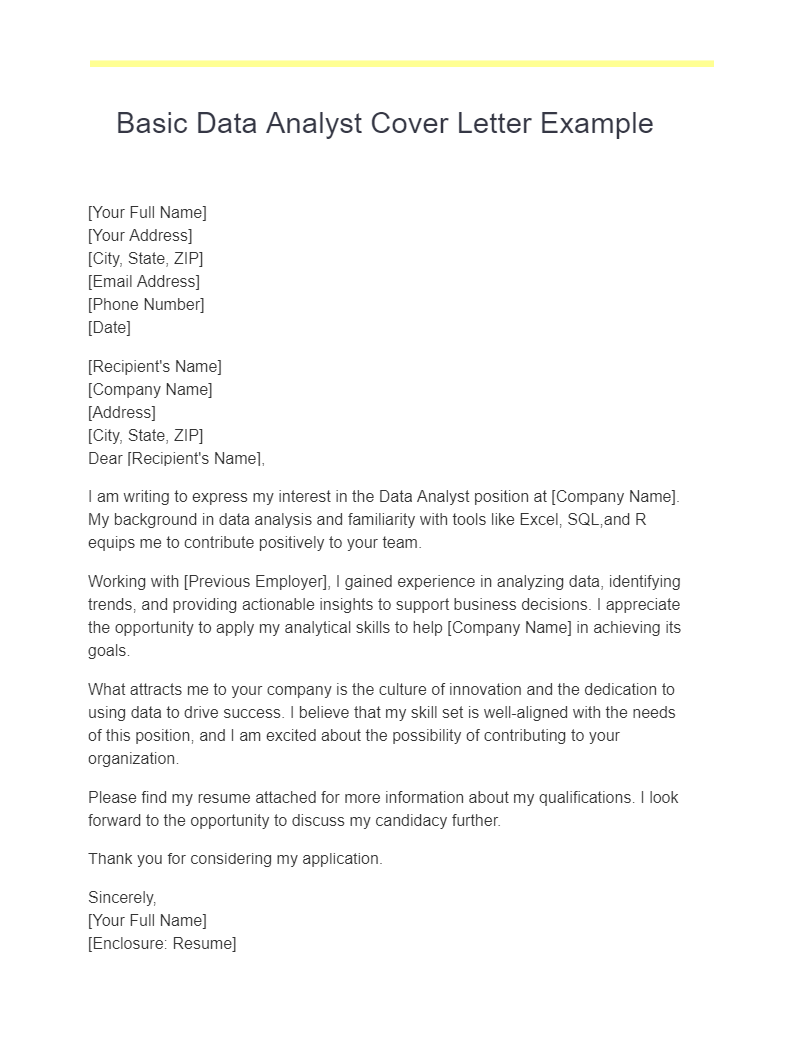
What do you write in a Cover Letter for a Data Analyst Role?
When crafting a cover letter for a Data Analyst role, you must focus on a few key areas:
1. Introduction: Open by stating the specific position you’re applying for, how you heard about it, and a brief summary of your qualifications.
2. Skills and Experience: Highlight your proficiency in tools and technologies used in data analysis, such as SQL, R, Python, Excel, etc. Describe your previous experiences in data collection, cleaning, analysis, and interpretation.
3. Relevant Achievements: Illustrate your past achievements in data analysis, mentioning how your insights contributed to achieving business goals or solving particular problems.
4. Understanding of the Role: Show that you understand the company’s needs for the position and how your skills align with those needs.
5. Enthusiasm for the Company: Mention what attracts you to the company and how your values align with its culture or mission.
6. Closing and Call to Action: Include a polite closing, expressing your eagerness to discuss your qualifications in further detail and thanking them for considering your application.
How Do I Write Cover Letter for a Data Analyst?
Here’s a guide to writing a Data Analyst cover letter:
1. Start with Professional Formatting: Include your contact information, the date, and the hiring manager’s contact information at the top.
2. Open with a Strong Introduction: Briefly mention the position, your background, and why you’re a good fit.
3. Detail Your Relevant Skills and Experience: Focus on specific skills like statistical analysis, data modeling, programming languages, etc., and how you have applied them in your previous roles.
4. Highlight Achievements and Contributions: Provide examples of how your analysis has directly impacted the business. Use numbers and specific outcomes if possible.
5. Showcase Your Interest in the Company: Research the company and mention specific projects or aspects that excite you about the opportunity.
6. Include a Professional Closing: Thank the recipient for their time, express your eagerness to discuss further, and sign off professionally.
Tips for Writing a Data Analyst Cover Letter
1. Tailor to the Company: Customize your cover letter to align with the company’s specific needs and culture.
2. Quantify Achievements: Whenever possible, use numbers to illustrate your success in previous roles.
3. Showcase Technical Proficiency: Highlight your skills in data analysis tools and technologies.
4. Avoid Jargon: Use clear and concise language that can be understood by non-technical readers.
5. Proofread: Ensure your cover letter is free from grammatical errors and typos.
6. Keep it Concise: A one-page cover letter is typically sufficient. Focus on key points and avoid unnecessary information.
Writing a cover letter for a Data Analyst role requires a focus on both technical proficiency and how those skills have been applied to create business value. Tailoring the letter to the specific company and role, highlighting relevant achievements, and maintaining a professional tone are essential for a successful application.
Text prompt
- Instructive
- Professional
Write a cover letter for a college student applying for an internship at an educational technology company
Form a cover letter for a high school student seeking a part-time job at a local bookstore.

IMAGES
VIDEO
COMMENTS
Learn what a cover letter enclosure is, why it's important and how to write one. A cover letter enclosure is a document you include with a physical cover letter, such as a resume or letter of recommendation.
Learn what a cover letter enclosure is and how to use it to your advantage. Find out how to list your attached documents clearly and professionally with examples and expert advice.
An enclosure is a document that is included with a cover letter, such as a resume, writing sample, or other supporting materials. Learn how to use enclosures effectively to showcase your qualifications and format them properly in your cover letter.
A cover letter enclosure is a document that you include with your cover letter, such as a CV or a portfolio. Learn how to write and format enclosures for cover letters and see some tips and examples.
A cover letter enclosure is a detailed notation at the end of your cover letter which outlines the documents that are included with your job application. Additional documents could include your resume, application form, recommendation letters, questionnaire, transcripts, and/or certificates.
The most commonly used cover letter enclosure is a reference from a company you worked for. It can be directly from your supervisor, the head of your department, or a HR professional in the company. The more recent this recommendation is, and the more details it includes, the more impressed the person reading your cover letter will be.
An enclosure in a cover letter refers to additional documents that are being sent along with the letter, such as a resume or a portfolio. The enclosure is typically mentioned at the end of the letter, after the closing, and is indicated by the word "Enclosure" or "Enclosures" followed by the number of documents included. ...
An enclosure notation in a cover letter is a formal way of informing the recipient that additional documents accompany the letter. This notation is typically placed at the end of the cover letter, serving as a signal to the hiring manager or recruiter to expect further materials.
When discussing an enclosure in a cover letter, we refer to additional documents in your application. These documents provide further information about your qualifications and experiences. It's crucial to mention them in your cover letter to alert the hiring manager that there's more to see than just the letter itself. Including suitable ...
An enclosure in a cover letter is a list of any additional documents you've included in your application. Typical enclosure documents include letters of recommendation, certificates, a portfolio, work samples, or written tests associated with the job application.
An enclosure means any additional documents that you have included with your cover letter, such as a resume, letters of recommendation or transcripts proving that you have a college degree. While it may seem obvious that the recipient of your cover letter would figure out that there are additional documents in the envelope, annotating ...
Enclosure on a cover letter refers to any additional documents or materials that you are including with your application. These could be your resume, portfolio, certificates, or any other relevant documents that you believe will provide further insight into your qualifications and suitability for the role. By indicating the inclusion of these ...
Learn what an enclosure is and how to cite one in a business letter with four simple steps and examples. An enclosure is another document that you add to a letter, such as a resume or an article, and you can note it at the bottom of the letter with a title and a description.
To include an enclosure with your cover letter, you should: Create a list of the documents that you want to include. Find your name at the end of your cover letter and double space after it. Type the word "Enclosure" if you are only including one document or "Enclosures" for two or more. You can also choose to use the word "Enclosed" instead.
A cover letter enclosure is a list of all the additional documents that you've attached with your application. Learn how to use it to your benefit, what to include and how to format it correctly.
In summary, the term ""enclosure"" in a cover letter indicates that additional documents are included with the letter. To elaborate, when you see ""enclosure"" at the end of a cover letter, it signifies that the sender has attached supplementary materials, such as a resume, portfolio, or other relevant documents, for the recipient's review. ...
Learn how to write a cover letter with six essential sections: header, salutation, opening paragraph, body, closing paragraph, and sign-off. Find tips, examples, and strategies for each part of a cover letter and how to use Teal's AI Resume Builder.
Cover Letters :: Learn English online - free exercises, explanations, games, teaching materials and plenty of information on English language. :: page Attachment ... Dictionary; auf Deutsch › Cram Up › Writing › Cover Letter › Cover Letters Sender's Address in a Cover Letter. Enclosure in a Cover Letter. If you wish to enclose documents ...
[Enclosure: Resume] A Simple cover letter should focus on your core skills in data analysis, tools you have used, and how your work has supported business growth. Keep it concise and tailored to the specific company and role. Details. File Format. PDF; Size: 28 KB. Download.
Learn how to use the enclosure notation in a business letter to indicate additional items that are attached to the letter. Find out the standard abbreviation, format and placement of the enclosure notation, and see a sample letter with enclosures.